Business and The Business Environment
VerifiedAdded on 2023/01/10
|17
|5241
|51
AI Summary
This project elaborates public sector with NHS organisation as being publically funded healthcare system of United States. The private sector through TESCO and voluntary sector by Oxfam is a major non-profit group with its purpose, legal structure and example.
Contribute Materials
Your contribution can guide someone’s learning journey. Share your
documents today.
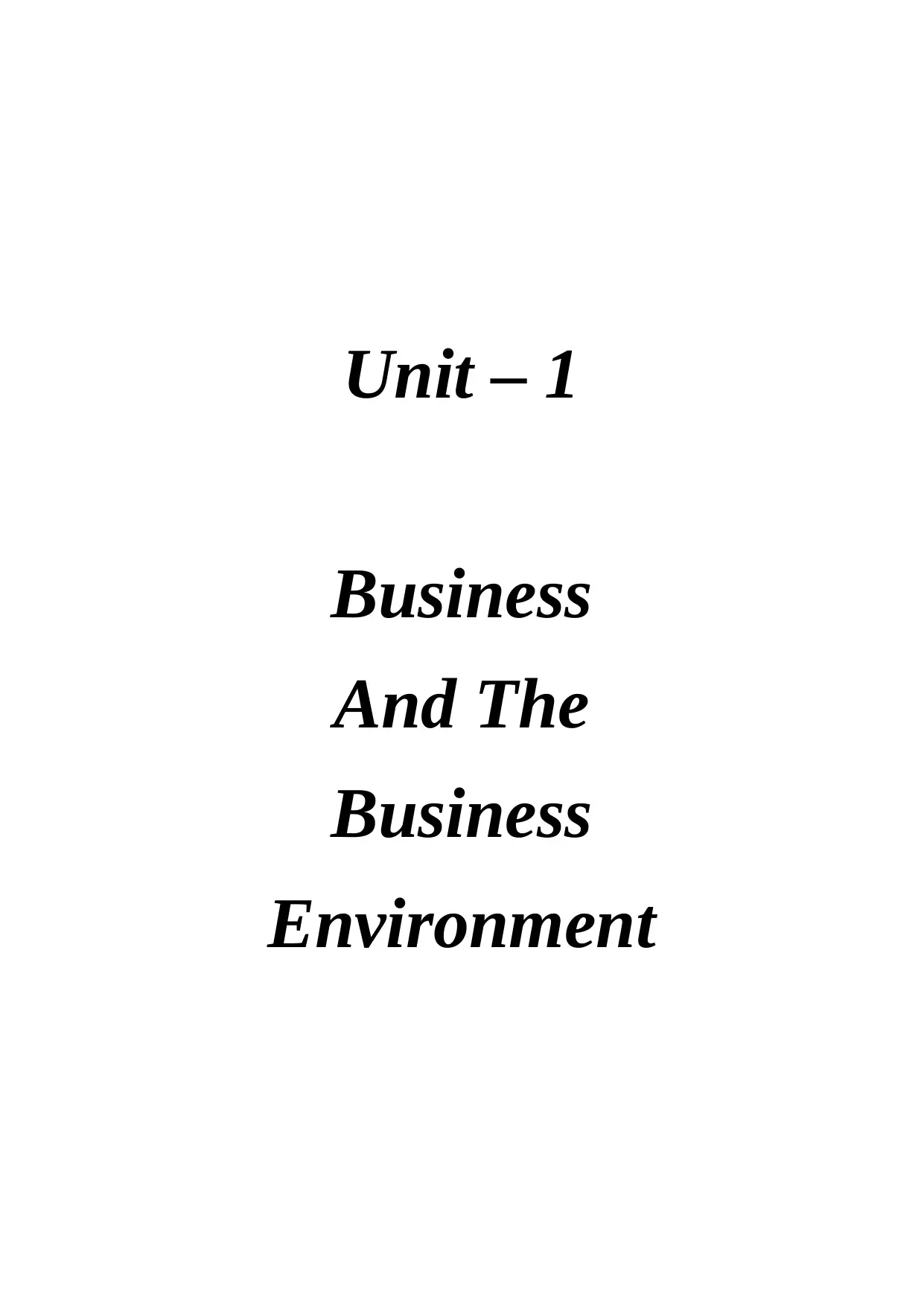
Unit – 1
Business
And The
Business
Environment
Business
And The
Business
Environment
Secure Best Marks with AI Grader
Need help grading? Try our AI Grader for instant feedback on your assignments.
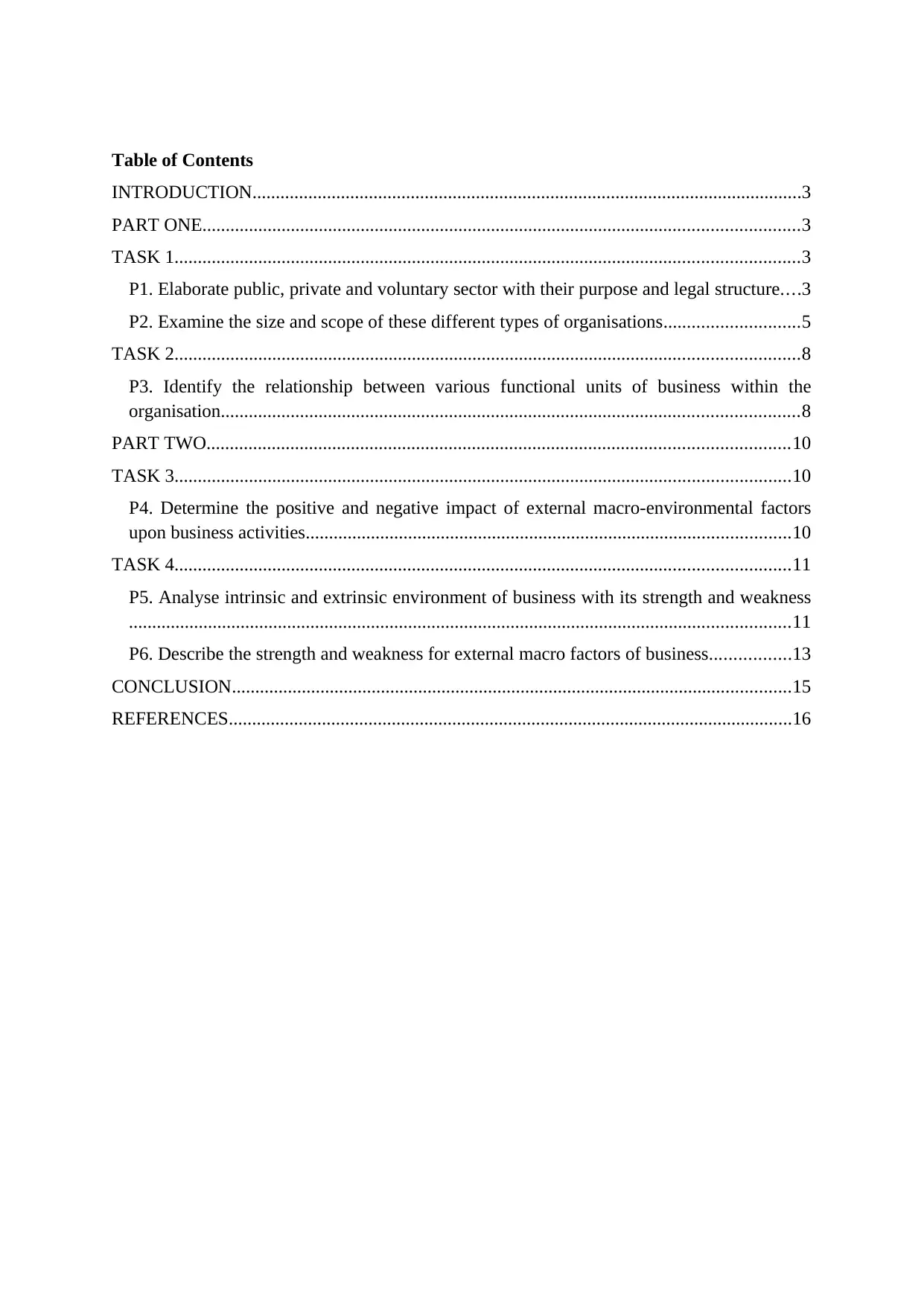
Table of Contents
INTRODUCTION......................................................................................................................3
PART ONE................................................................................................................................3
TASK 1......................................................................................................................................3
P1. Elaborate public, private and voluntary sector with their purpose and legal structure....3
P2. Examine the size and scope of these different types of organisations.............................5
TASK 2......................................................................................................................................8
P3. Identify the relationship between various functional units of business within the
organisation............................................................................................................................8
PART TWO.............................................................................................................................10
TASK 3....................................................................................................................................10
P4. Determine the positive and negative impact of external macro-environmental factors
upon business activities........................................................................................................10
TASK 4....................................................................................................................................11
P5. Analyse intrinsic and extrinsic environment of business with its strength and weakness
..............................................................................................................................................11
P6. Describe the strength and weakness for external macro factors of business.................13
CONCLUSION........................................................................................................................15
REFERENCES.........................................................................................................................16
INTRODUCTION......................................................................................................................3
PART ONE................................................................................................................................3
TASK 1......................................................................................................................................3
P1. Elaborate public, private and voluntary sector with their purpose and legal structure....3
P2. Examine the size and scope of these different types of organisations.............................5
TASK 2......................................................................................................................................8
P3. Identify the relationship between various functional units of business within the
organisation............................................................................................................................8
PART TWO.............................................................................................................................10
TASK 3....................................................................................................................................10
P4. Determine the positive and negative impact of external macro-environmental factors
upon business activities........................................................................................................10
TASK 4....................................................................................................................................11
P5. Analyse intrinsic and extrinsic environment of business with its strength and weakness
..............................................................................................................................................11
P6. Describe the strength and weakness for external macro factors of business.................13
CONCLUSION........................................................................................................................15
REFERENCES.........................................................................................................................16
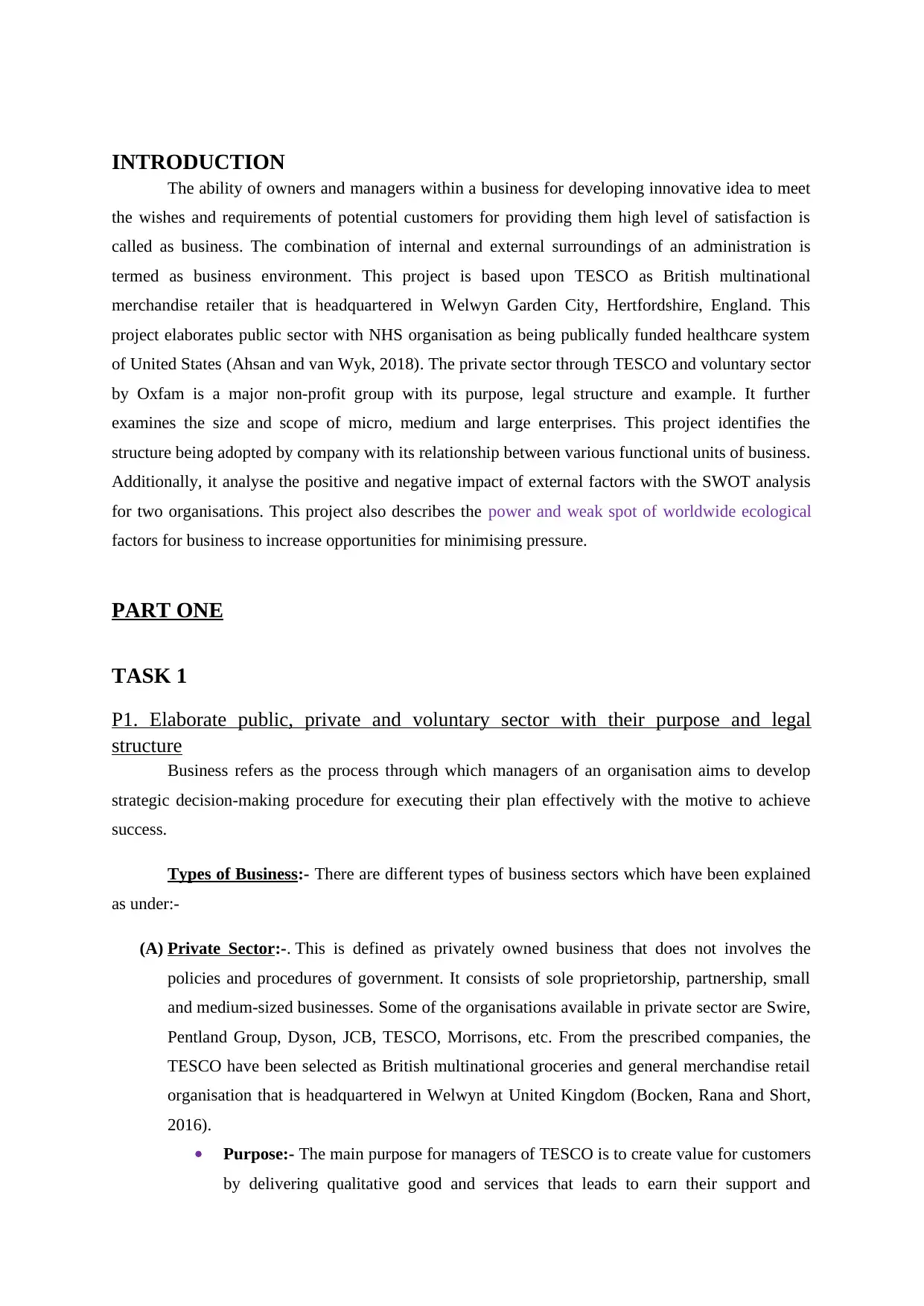
INTRODUCTION
The ability of owners and managers within a business for developing innovative idea to meet
the wishes and requirements of potential customers for providing them high level of satisfaction is
called as business. The combination of internal and external surroundings of an administration is
termed as business environment. This project is based upon TESCO as British multinational
merchandise retailer that is headquartered in Welwyn Garden City, Hertfordshire, England. This
project elaborates public sector with NHS organisation as being publically funded healthcare system
of United States (Ahsan and van Wyk, 2018). The private sector through TESCO and voluntary sector
by Oxfam is a major non-profit group with its purpose, legal structure and example. It further
examines the size and scope of micro, medium and large enterprises. This project identifies the
structure being adopted by company with its relationship between various functional units of business.
Additionally, it analyse the positive and negative impact of external factors with the SWOT analysis
for two organisations. This project also describes the power and weak spot of worldwide ecological
factors for business to increase opportunities for minimising pressure.
PART ONE
TASK 1
P1. Elaborate public, private and voluntary sector with their purpose and legal
structure
Business refers as the process through which managers of an organisation aims to develop
strategic decision-making procedure for executing their plan effectively with the motive to achieve
success.
Types of Business:- There are different types of business sectors which have been explained
as under:-
(A) Private Sector:-. This is defined as privately owned business that does not involves the
policies and procedures of government. It consists of sole proprietorship, partnership, small
and medium-sized businesses. Some of the organisations available in private sector are Swire,
Pentland Group, Dyson, JCB, TESCO, Morrisons, etc. From the prescribed companies, the
TESCO have been selected as British multinational groceries and general merchandise retail
organisation that is headquartered in Welwyn at United Kingdom (Bocken, Rana and Short,
2016).
Purpose:- The main purpose for managers of TESCO is to create value for customers
by delivering qualitative good and services that leads to earn their support and
The ability of owners and managers within a business for developing innovative idea to meet
the wishes and requirements of potential customers for providing them high level of satisfaction is
called as business. The combination of internal and external surroundings of an administration is
termed as business environment. This project is based upon TESCO as British multinational
merchandise retailer that is headquartered in Welwyn Garden City, Hertfordshire, England. This
project elaborates public sector with NHS organisation as being publically funded healthcare system
of United States (Ahsan and van Wyk, 2018). The private sector through TESCO and voluntary sector
by Oxfam is a major non-profit group with its purpose, legal structure and example. It further
examines the size and scope of micro, medium and large enterprises. This project identifies the
structure being adopted by company with its relationship between various functional units of business.
Additionally, it analyse the positive and negative impact of external factors with the SWOT analysis
for two organisations. This project also describes the power and weak spot of worldwide ecological
factors for business to increase opportunities for minimising pressure.
PART ONE
TASK 1
P1. Elaborate public, private and voluntary sector with their purpose and legal
structure
Business refers as the process through which managers of an organisation aims to develop
strategic decision-making procedure for executing their plan effectively with the motive to achieve
success.
Types of Business:- There are different types of business sectors which have been explained
as under:-
(A) Private Sector:-. This is defined as privately owned business that does not involves the
policies and procedures of government. It consists of sole proprietorship, partnership, small
and medium-sized businesses. Some of the organisations available in private sector are Swire,
Pentland Group, Dyson, JCB, TESCO, Morrisons, etc. From the prescribed companies, the
TESCO have been selected as British multinational groceries and general merchandise retail
organisation that is headquartered in Welwyn at United Kingdom (Bocken, Rana and Short,
2016).
Purpose:- The main purpose for managers of TESCO is to create value for customers
by delivering qualitative good and services that leads to earn their support and
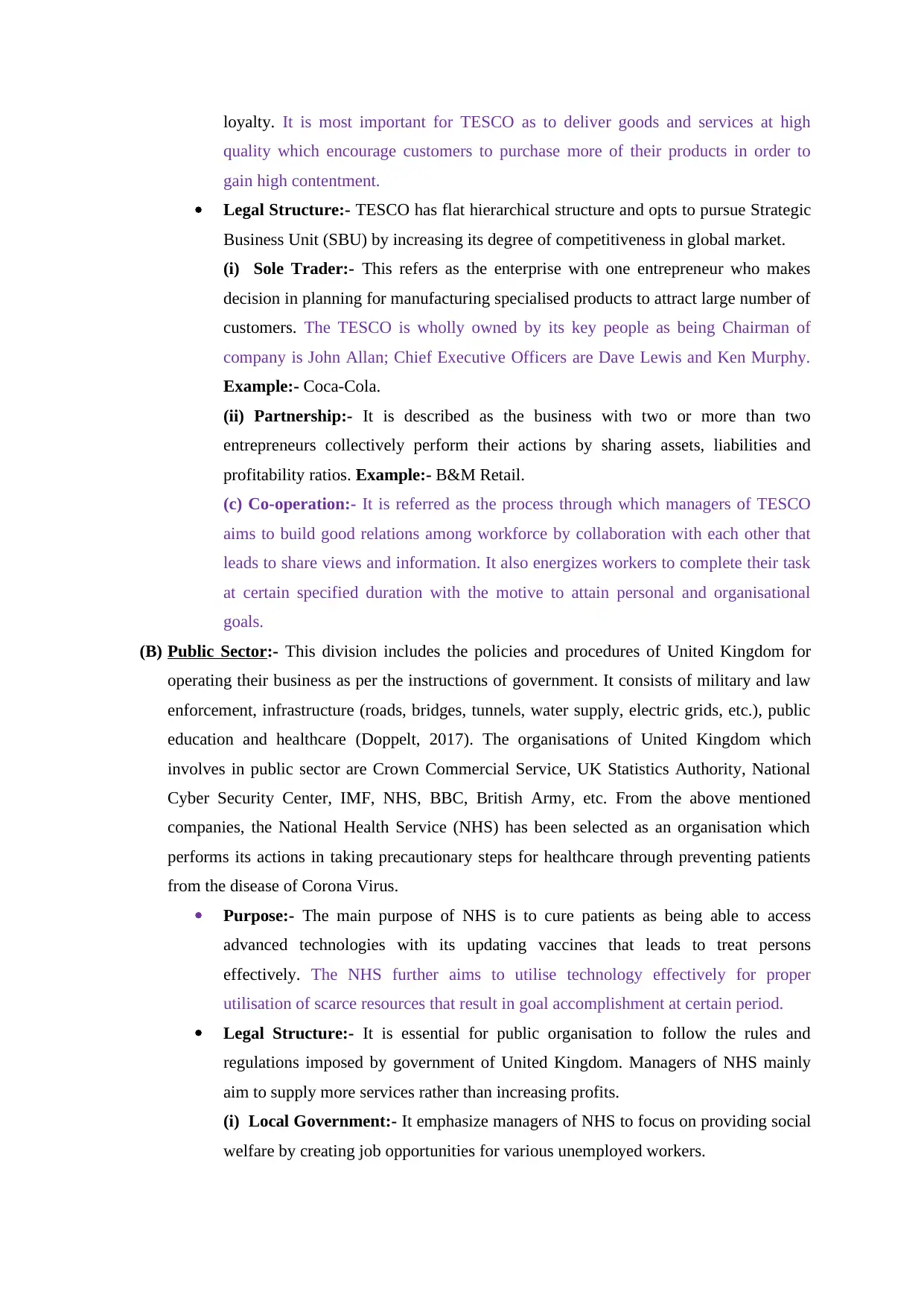
loyalty. It is most important for TESCO as to deliver goods and services at high
quality which encourage customers to purchase more of their products in order to
gain high contentment.
Legal Structure:- TESCO has flat hierarchical structure and opts to pursue Strategic
Business Unit (SBU) by increasing its degree of competitiveness in global market.
(i) Sole Trader:- This refers as the enterprise with one entrepreneur who makes
decision in planning for manufacturing specialised products to attract large number of
customers. The TESCO is wholly owned by its key people as being Chairman of
company is John Allan; Chief Executive Officers are Dave Lewis and Ken Murphy.
Example:- Coca-Cola.
(ii) Partnership:- It is described as the business with two or more than two
entrepreneurs collectively perform their actions by sharing assets, liabilities and
profitability ratios. Example:- B&M Retail.
(c) Co-operation:- It is referred as the process through which managers of TESCO
aims to build good relations among workforce by collaboration with each other that
leads to share views and information. It also energizes workers to complete their task
at certain specified duration with the motive to attain personal and organisational
goals.
(B) Public Sector:- This division includes the policies and procedures of United Kingdom for
operating their business as per the instructions of government. It consists of military and law
enforcement, infrastructure (roads, bridges, tunnels, water supply, electric grids, etc.), public
education and healthcare (Doppelt, 2017). The organisations of United Kingdom which
involves in public sector are Crown Commercial Service, UK Statistics Authority, National
Cyber Security Center, IMF, NHS, BBC, British Army, etc. From the above mentioned
companies, the National Health Service (NHS) has been selected as an organisation which
performs its actions in taking precautionary steps for healthcare through preventing patients
from the disease of Corona Virus.
Purpose:- The main purpose of NHS is to cure patients as being able to access
advanced technologies with its updating vaccines that leads to treat persons
effectively. The NHS further aims to utilise technology effectively for proper
utilisation of scarce resources that result in goal accomplishment at certain period.
Legal Structure:- It is essential for public organisation to follow the rules and
regulations imposed by government of United Kingdom. Managers of NHS mainly
aim to supply more services rather than increasing profits.
(i) Local Government:- It emphasize managers of NHS to focus on providing social
welfare by creating job opportunities for various unemployed workers.
quality which encourage customers to purchase more of their products in order to
gain high contentment.
Legal Structure:- TESCO has flat hierarchical structure and opts to pursue Strategic
Business Unit (SBU) by increasing its degree of competitiveness in global market.
(i) Sole Trader:- This refers as the enterprise with one entrepreneur who makes
decision in planning for manufacturing specialised products to attract large number of
customers. The TESCO is wholly owned by its key people as being Chairman of
company is John Allan; Chief Executive Officers are Dave Lewis and Ken Murphy.
Example:- Coca-Cola.
(ii) Partnership:- It is described as the business with two or more than two
entrepreneurs collectively perform their actions by sharing assets, liabilities and
profitability ratios. Example:- B&M Retail.
(c) Co-operation:- It is referred as the process through which managers of TESCO
aims to build good relations among workforce by collaboration with each other that
leads to share views and information. It also energizes workers to complete their task
at certain specified duration with the motive to attain personal and organisational
goals.
(B) Public Sector:- This division includes the policies and procedures of United Kingdom for
operating their business as per the instructions of government. It consists of military and law
enforcement, infrastructure (roads, bridges, tunnels, water supply, electric grids, etc.), public
education and healthcare (Doppelt, 2017). The organisations of United Kingdom which
involves in public sector are Crown Commercial Service, UK Statistics Authority, National
Cyber Security Center, IMF, NHS, BBC, British Army, etc. From the above mentioned
companies, the National Health Service (NHS) has been selected as an organisation which
performs its actions in taking precautionary steps for healthcare through preventing patients
from the disease of Corona Virus.
Purpose:- The main purpose of NHS is to cure patients as being able to access
advanced technologies with its updating vaccines that leads to treat persons
effectively. The NHS further aims to utilise technology effectively for proper
utilisation of scarce resources that result in goal accomplishment at certain period.
Legal Structure:- It is essential for public organisation to follow the rules and
regulations imposed by government of United Kingdom. Managers of NHS mainly
aim to supply more services rather than increasing profits.
(i) Local Government:- It emphasize managers of NHS to focus on providing social
welfare by creating job opportunities for various unemployed workers.
Secure Best Marks with AI Grader
Need help grading? Try our AI Grader for instant feedback on your assignments.
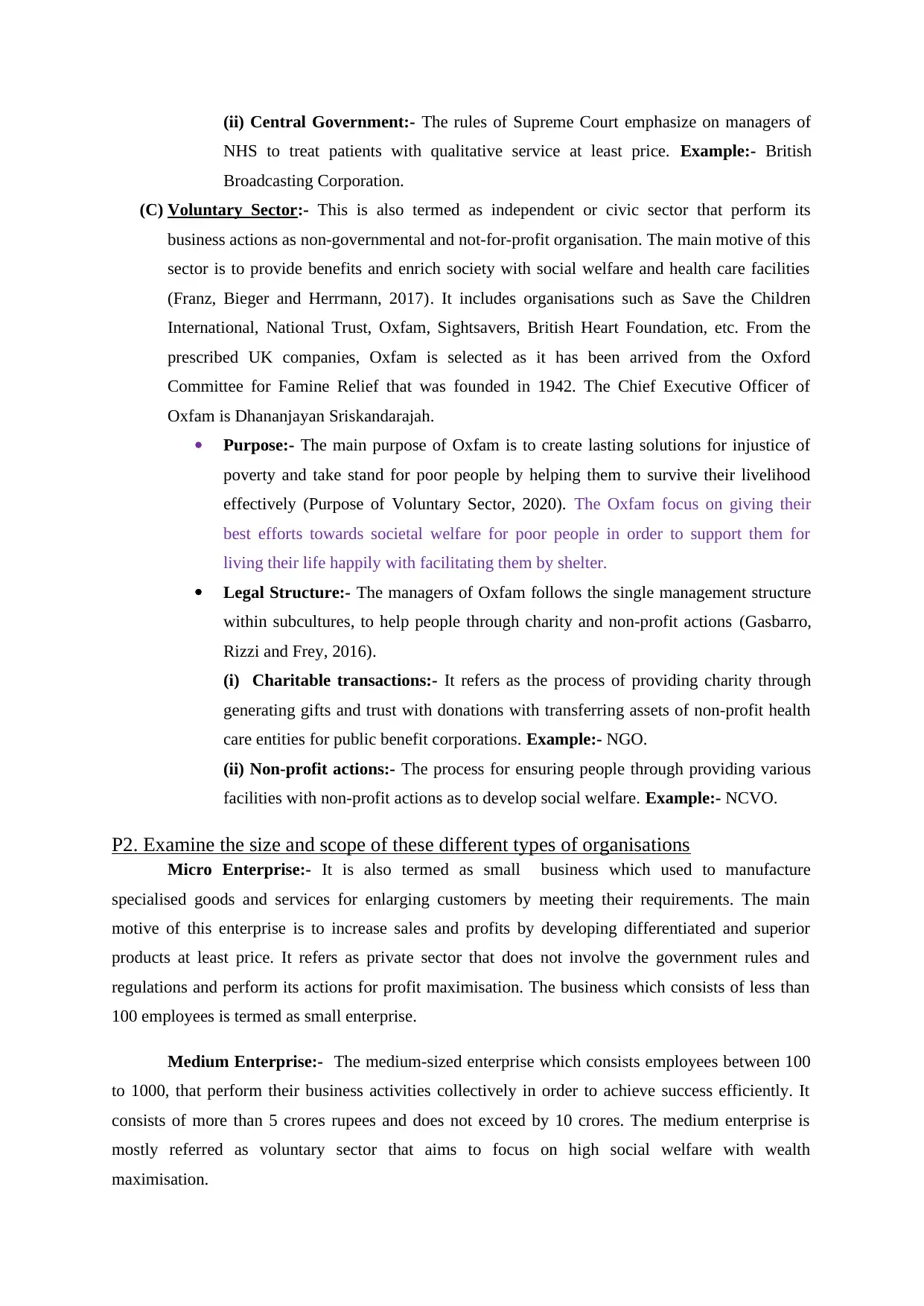
(ii) Central Government:- The rules of Supreme Court emphasize on managers of
NHS to treat patients with qualitative service at least price. Example:- British
Broadcasting Corporation.
(C) Voluntary Sector:- This is also termed as independent or civic sector that perform its
business actions as non-governmental and not-for-profit organisation. The main motive of this
sector is to provide benefits and enrich society with social welfare and health care facilities
(Franz, Bieger and Herrmann, 2017). It includes organisations such as Save the Children
International, National Trust, Oxfam, Sightsavers, British Heart Foundation, etc. From the
prescribed UK companies, Oxfam is selected as it has been arrived from the Oxford
Committee for Famine Relief that was founded in 1942. The Chief Executive Officer of
Oxfam is Dhananjayan Sriskandarajah.
Purpose:- The main purpose of Oxfam is to create lasting solutions for injustice of
poverty and take stand for poor people by helping them to survive their livelihood
effectively (Purpose of Voluntary Sector, 2020). The Oxfam focus on giving their
best efforts towards societal welfare for poor people in order to support them for
living their life happily with facilitating them by shelter.
Legal Structure:- The managers of Oxfam follows the single management structure
within subcultures, to help people through charity and non-profit actions (Gasbarro,
Rizzi and Frey, 2016).
(i) Charitable transactions:- It refers as the process of providing charity through
generating gifts and trust with donations with transferring assets of non-profit health
care entities for public benefit corporations. Example:- NGO.
(ii) Non-profit actions:- The process for ensuring people through providing various
facilities with non-profit actions as to develop social welfare. Example:- NCVO.
P2. Examine the size and scope of these different types of organisations
Micro Enterprise:- It is also termed as small business which used to manufacture
specialised goods and services for enlarging customers by meeting their requirements. The main
motive of this enterprise is to increase sales and profits by developing differentiated and superior
products at least price. It refers as private sector that does not involve the government rules and
regulations and perform its actions for profit maximisation. The business which consists of less than
100 employees is termed as small enterprise.
Medium Enterprise:- The medium-sized enterprise which consists employees between 100
to 1000, that perform their business activities collectively in order to achieve success efficiently. It
consists of more than 5 crores rupees and does not exceed by 10 crores. The medium enterprise is
mostly referred as voluntary sector that aims to focus on high social welfare with wealth
maximisation.
NHS to treat patients with qualitative service at least price. Example:- British
Broadcasting Corporation.
(C) Voluntary Sector:- This is also termed as independent or civic sector that perform its
business actions as non-governmental and not-for-profit organisation. The main motive of this
sector is to provide benefits and enrich society with social welfare and health care facilities
(Franz, Bieger and Herrmann, 2017). It includes organisations such as Save the Children
International, National Trust, Oxfam, Sightsavers, British Heart Foundation, etc. From the
prescribed UK companies, Oxfam is selected as it has been arrived from the Oxford
Committee for Famine Relief that was founded in 1942. The Chief Executive Officer of
Oxfam is Dhananjayan Sriskandarajah.
Purpose:- The main purpose of Oxfam is to create lasting solutions for injustice of
poverty and take stand for poor people by helping them to survive their livelihood
effectively (Purpose of Voluntary Sector, 2020). The Oxfam focus on giving their
best efforts towards societal welfare for poor people in order to support them for
living their life happily with facilitating them by shelter.
Legal Structure:- The managers of Oxfam follows the single management structure
within subcultures, to help people through charity and non-profit actions (Gasbarro,
Rizzi and Frey, 2016).
(i) Charitable transactions:- It refers as the process of providing charity through
generating gifts and trust with donations with transferring assets of non-profit health
care entities for public benefit corporations. Example:- NGO.
(ii) Non-profit actions:- The process for ensuring people through providing various
facilities with non-profit actions as to develop social welfare. Example:- NCVO.
P2. Examine the size and scope of these different types of organisations
Micro Enterprise:- It is also termed as small business which used to manufacture
specialised goods and services for enlarging customers by meeting their requirements. The main
motive of this enterprise is to increase sales and profits by developing differentiated and superior
products at least price. It refers as private sector that does not involve the government rules and
regulations and perform its actions for profit maximisation. The business which consists of less than
100 employees is termed as small enterprise.
Medium Enterprise:- The medium-sized enterprise which consists employees between 100
to 1000, that perform their business activities collectively in order to achieve success efficiently. It
consists of more than 5 crores rupees and does not exceed by 10 crores. The medium enterprise is
mostly referred as voluntary sector that aims to focus on high social welfare with wealth
maximisation.
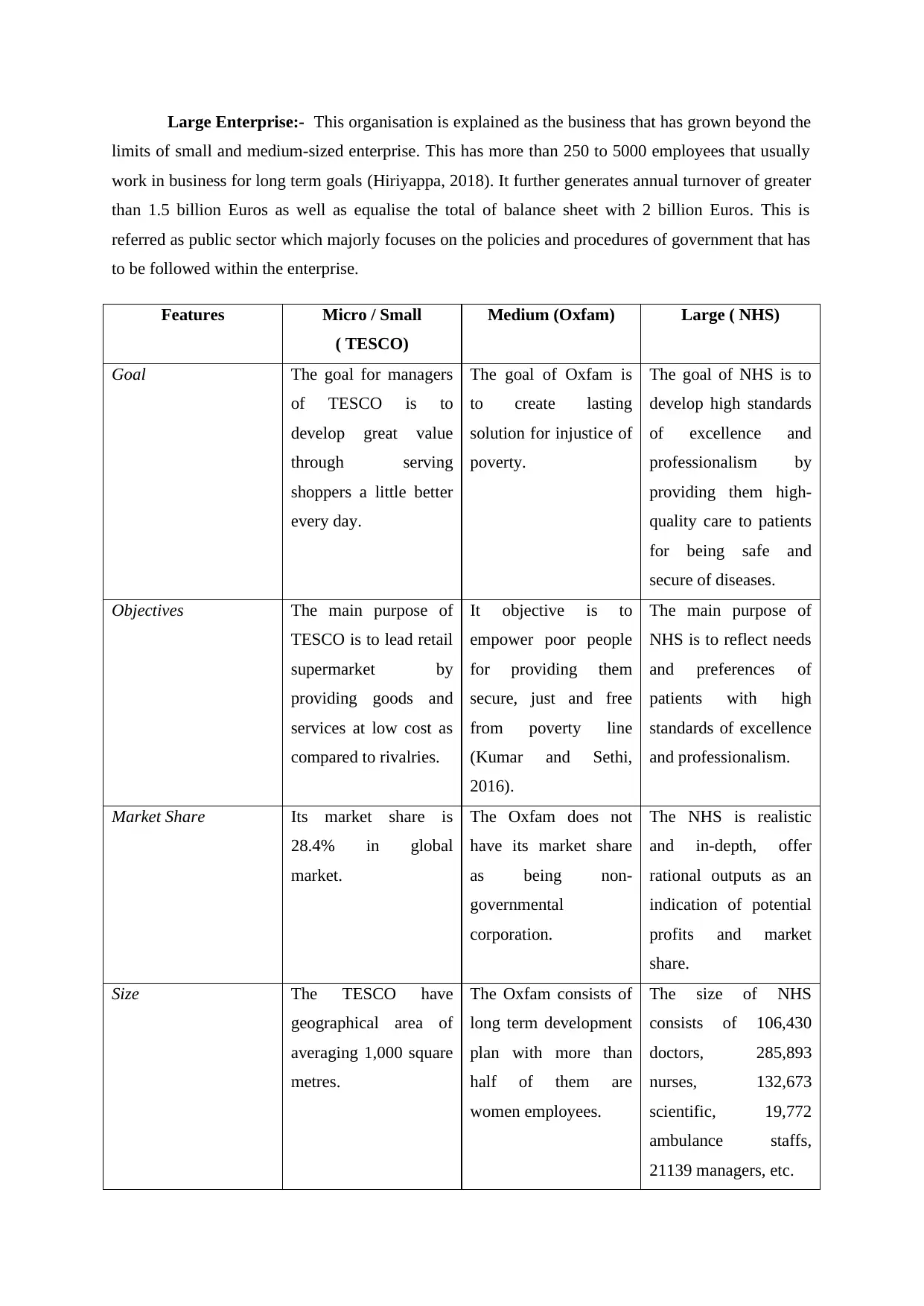
Large Enterprise:- This organisation is explained as the business that has grown beyond the
limits of small and medium-sized enterprise. This has more than 250 to 5000 employees that usually
work in business for long term goals (Hiriyappa, 2018). It further generates annual turnover of greater
than 1.5 billion Euros as well as equalise the total of balance sheet with 2 billion Euros. This is
referred as public sector which majorly focuses on the policies and procedures of government that has
to be followed within the enterprise.
Features Micro / Small
( TESCO)
Medium (Oxfam) Large ( NHS)
Goal The goal for managers
of TESCO is to
develop great value
through serving
shoppers a little better
every day.
The goal of Oxfam is
to create lasting
solution for injustice of
poverty.
The goal of NHS is to
develop high standards
of excellence and
professionalism by
providing them high-
quality care to patients
for being safe and
secure of diseases.
Objectives The main purpose of
TESCO is to lead retail
supermarket by
providing goods and
services at low cost as
compared to rivalries.
It objective is to
empower poor people
for providing them
secure, just and free
from poverty line
(Kumar and Sethi,
2016).
The main purpose of
NHS is to reflect needs
and preferences of
patients with high
standards of excellence
and professionalism.
Market Share Its market share is
28.4% in global
market.
The Oxfam does not
have its market share
as being non-
governmental
corporation.
The NHS is realistic
and in-depth, offer
rational outputs as an
indication of potential
profits and market
share.
Size The TESCO have
geographical area of
averaging 1,000 square
metres.
The Oxfam consists of
long term development
plan with more than
half of them are
women employees.
The size of NHS
consists of 106,430
doctors, 285,893
nurses, 132,673
scientific, 19,772
ambulance staffs,
21139 managers, etc.
limits of small and medium-sized enterprise. This has more than 250 to 5000 employees that usually
work in business for long term goals (Hiriyappa, 2018). It further generates annual turnover of greater
than 1.5 billion Euros as well as equalise the total of balance sheet with 2 billion Euros. This is
referred as public sector which majorly focuses on the policies and procedures of government that has
to be followed within the enterprise.
Features Micro / Small
( TESCO)
Medium (Oxfam) Large ( NHS)
Goal The goal for managers
of TESCO is to
develop great value
through serving
shoppers a little better
every day.
The goal of Oxfam is
to create lasting
solution for injustice of
poverty.
The goal of NHS is to
develop high standards
of excellence and
professionalism by
providing them high-
quality care to patients
for being safe and
secure of diseases.
Objectives The main purpose of
TESCO is to lead retail
supermarket by
providing goods and
services at low cost as
compared to rivalries.
It objective is to
empower poor people
for providing them
secure, just and free
from poverty line
(Kumar and Sethi,
2016).
The main purpose of
NHS is to reflect needs
and preferences of
patients with high
standards of excellence
and professionalism.
Market Share Its market share is
28.4% in global
market.
The Oxfam does not
have its market share
as being non-
governmental
corporation.
The NHS is realistic
and in-depth, offer
rational outputs as an
indication of potential
profits and market
share.
Size The TESCO have
geographical area of
averaging 1,000 square
metres.
The Oxfam consists of
long term development
plan with more than
half of them are
women employees.
The size of NHS
consists of 106,430
doctors, 285,893
nurses, 132,673
scientific, 19,772
ambulance staffs,
21139 managers, etc.
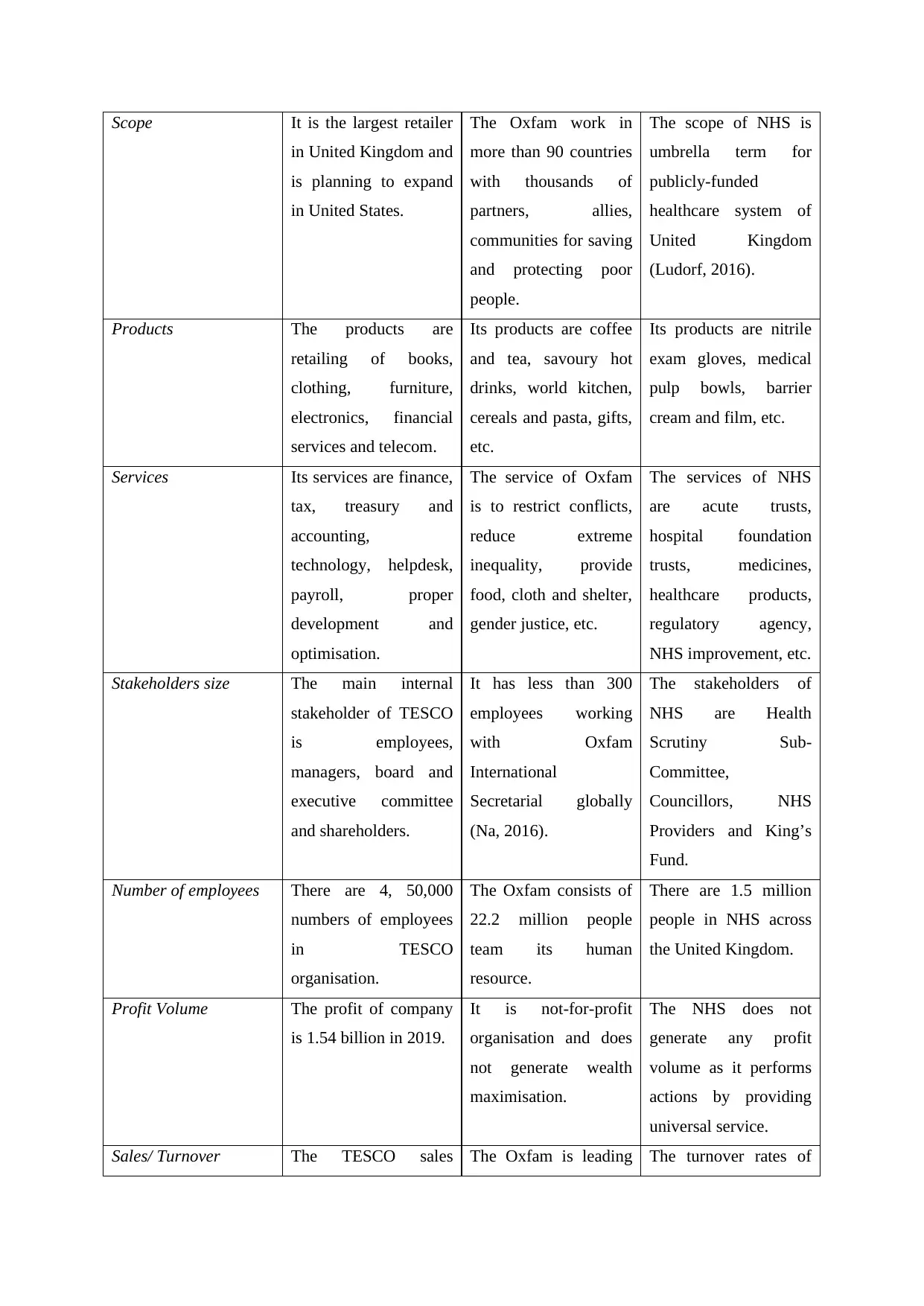
Scope It is the largest retailer
in United Kingdom and
is planning to expand
in United States.
The Oxfam work in
more than 90 countries
with thousands of
partners, allies,
communities for saving
and protecting poor
people.
The scope of NHS is
umbrella term for
publicly-funded
healthcare system of
United Kingdom
(Ludorf, 2016).
Products The products are
retailing of books,
clothing, furniture,
electronics, financial
services and telecom.
Its products are coffee
and tea, savoury hot
drinks, world kitchen,
cereals and pasta, gifts,
etc.
Its products are nitrile
exam gloves, medical
pulp bowls, barrier
cream and film, etc.
Services Its services are finance,
tax, treasury and
accounting,
technology, helpdesk,
payroll, proper
development and
optimisation.
The service of Oxfam
is to restrict conflicts,
reduce extreme
inequality, provide
food, cloth and shelter,
gender justice, etc.
The services of NHS
are acute trusts,
hospital foundation
trusts, medicines,
healthcare products,
regulatory agency,
NHS improvement, etc.
Stakeholders size The main internal
stakeholder of TESCO
is employees,
managers, board and
executive committee
and shareholders.
It has less than 300
employees working
with Oxfam
International
Secretarial globally
(Na, 2016).
The stakeholders of
NHS are Health
Scrutiny Sub-
Committee,
Councillors, NHS
Providers and King’s
Fund.
Number of employees There are 4, 50,000
numbers of employees
in TESCO
organisation.
The Oxfam consists of
22.2 million people
team its human
resource.
There are 1.5 million
people in NHS across
the United Kingdom.
Profit Volume The profit of company
is 1.54 billion in 2019.
It is not-for-profit
organisation and does
not generate wealth
maximisation.
The NHS does not
generate any profit
volume as it performs
actions by providing
universal service.
Sales/ Turnover The TESCO sales The Oxfam is leading The turnover rates of
in United Kingdom and
is planning to expand
in United States.
The Oxfam work in
more than 90 countries
with thousands of
partners, allies,
communities for saving
and protecting poor
people.
The scope of NHS is
umbrella term for
publicly-funded
healthcare system of
United Kingdom
(Ludorf, 2016).
Products The products are
retailing of books,
clothing, furniture,
electronics, financial
services and telecom.
Its products are coffee
and tea, savoury hot
drinks, world kitchen,
cereals and pasta, gifts,
etc.
Its products are nitrile
exam gloves, medical
pulp bowls, barrier
cream and film, etc.
Services Its services are finance,
tax, treasury and
accounting,
technology, helpdesk,
payroll, proper
development and
optimisation.
The service of Oxfam
is to restrict conflicts,
reduce extreme
inequality, provide
food, cloth and shelter,
gender justice, etc.
The services of NHS
are acute trusts,
hospital foundation
trusts, medicines,
healthcare products,
regulatory agency,
NHS improvement, etc.
Stakeholders size The main internal
stakeholder of TESCO
is employees,
managers, board and
executive committee
and shareholders.
It has less than 300
employees working
with Oxfam
International
Secretarial globally
(Na, 2016).
The stakeholders of
NHS are Health
Scrutiny Sub-
Committee,
Councillors, NHS
Providers and King’s
Fund.
Number of employees There are 4, 50,000
numbers of employees
in TESCO
organisation.
The Oxfam consists of
22.2 million people
team its human
resource.
There are 1.5 million
people in NHS across
the United Kingdom.
Profit Volume The profit of company
is 1.54 billion in 2019.
It is not-for-profit
organisation and does
not generate wealth
maximisation.
The NHS does not
generate any profit
volume as it performs
actions by providing
universal service.
Sales/ Turnover The TESCO sales The Oxfam is leading The turnover rates of
Paraphrase This Document
Need a fresh take? Get an instant paraphrase of this document with our AI Paraphraser
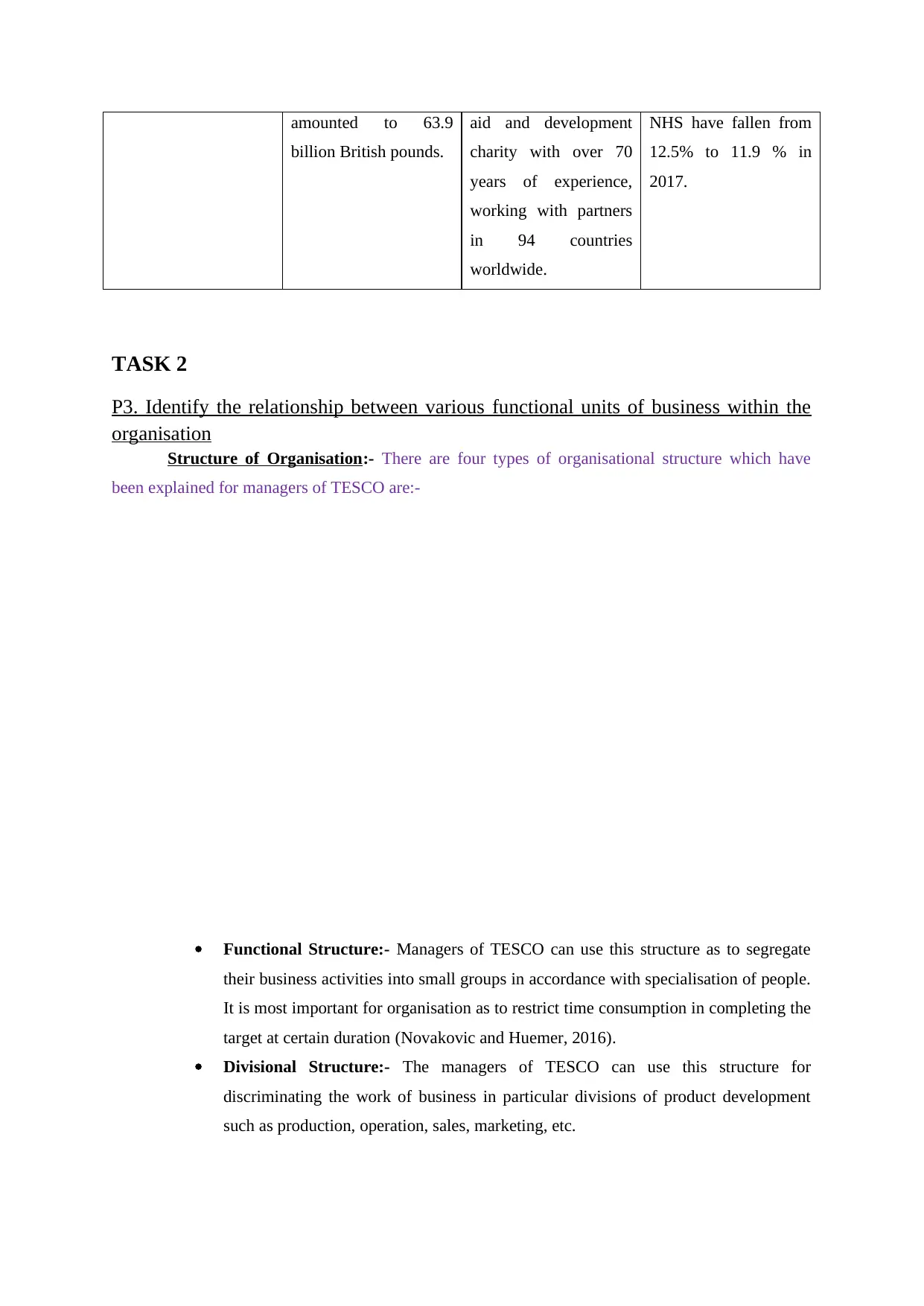
amounted to 63.9
billion British pounds.
aid and development
charity with over 70
years of experience,
working with partners
in 94 countries
worldwide.
NHS have fallen from
12.5% to 11.9 % in
2017.
TASK 2
P3. Identify the relationship between various functional units of business within the
organisation
Structure of Organisation:- There are four types of organisational structure which have
been explained for managers of TESCO are:-
Functional Structure:- Managers of TESCO can use this structure as to segregate
their business activities into small groups in accordance with specialisation of people.
It is most important for organisation as to restrict time consumption in completing the
target at certain duration (Novakovic and Huemer, 2016).
Divisional Structure:- The managers of TESCO can use this structure for
discriminating the work of business in particular divisions of product development
such as production, operation, sales, marketing, etc.
billion British pounds.
aid and development
charity with over 70
years of experience,
working with partners
in 94 countries
worldwide.
NHS have fallen from
12.5% to 11.9 % in
2017.
TASK 2
P3. Identify the relationship between various functional units of business within the
organisation
Structure of Organisation:- There are four types of organisational structure which have
been explained for managers of TESCO are:-
Functional Structure:- Managers of TESCO can use this structure as to segregate
their business activities into small groups in accordance with specialisation of people.
It is most important for organisation as to restrict time consumption in completing the
target at certain duration (Novakovic and Huemer, 2016).
Divisional Structure:- The managers of TESCO can use this structure for
discriminating the work of business in particular divisions of product development
such as production, operation, sales, marketing, etc.
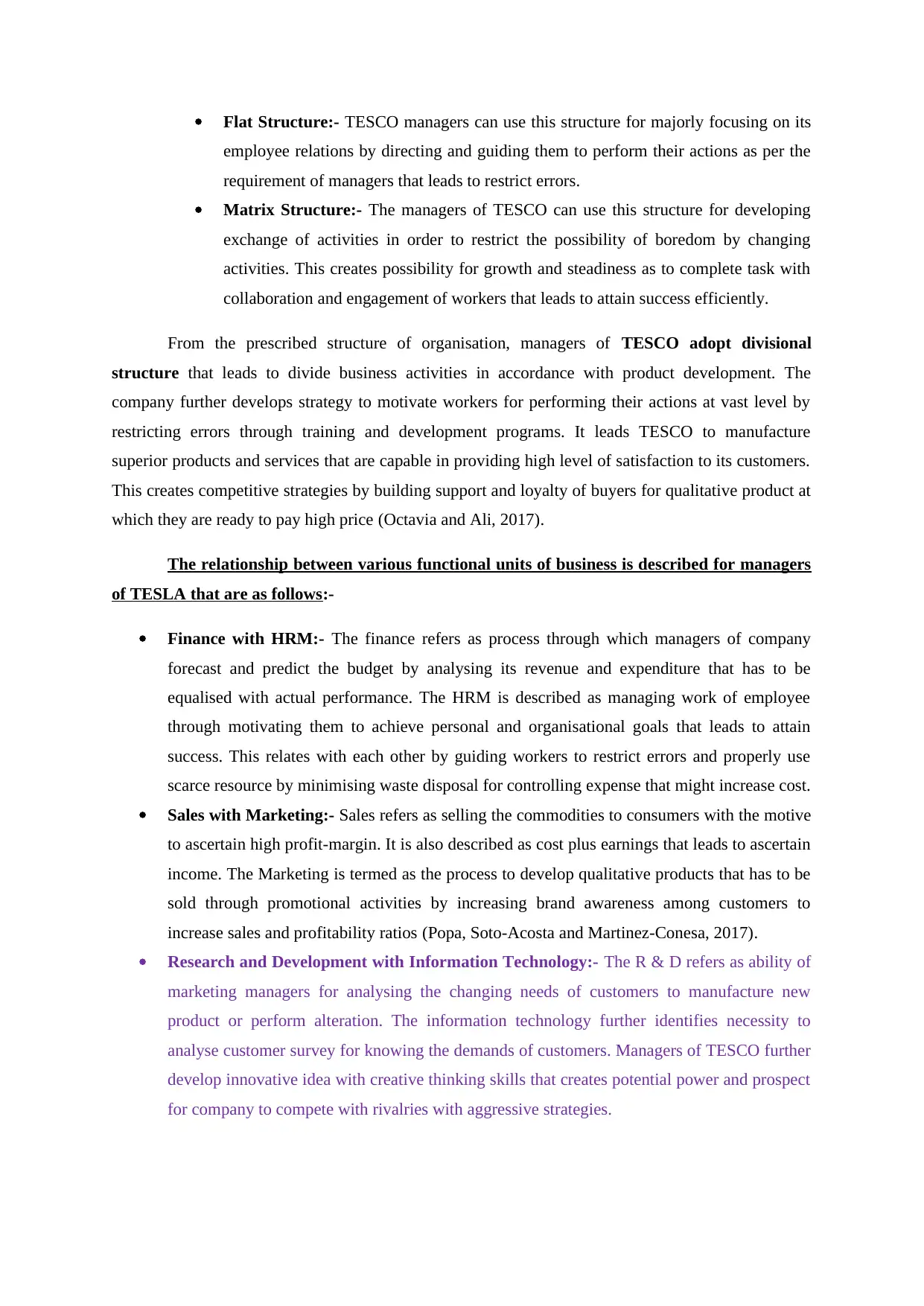
Flat Structure:- TESCO managers can use this structure for majorly focusing on its
employee relations by directing and guiding them to perform their actions as per the
requirement of managers that leads to restrict errors.
Matrix Structure:- The managers of TESCO can use this structure for developing
exchange of activities in order to restrict the possibility of boredom by changing
activities. This creates possibility for growth and steadiness as to complete task with
collaboration and engagement of workers that leads to attain success efficiently.
From the prescribed structure of organisation, managers of TESCO adopt divisional
structure that leads to divide business activities in accordance with product development. The
company further develops strategy to motivate workers for performing their actions at vast level by
restricting errors through training and development programs. It leads TESCO to manufacture
superior products and services that are capable in providing high level of satisfaction to its customers.
This creates competitive strategies by building support and loyalty of buyers for qualitative product at
which they are ready to pay high price (Octavia and Ali, 2017).
The relationship between various functional units of business is described for managers
of TESLA that are as follows:-
Finance with HRM:- The finance refers as process through which managers of company
forecast and predict the budget by analysing its revenue and expenditure that has to be
equalised with actual performance. The HRM is described as managing work of employee
through motivating them to achieve personal and organisational goals that leads to attain
success. This relates with each other by guiding workers to restrict errors and properly use
scarce resource by minimising waste disposal for controlling expense that might increase cost.
Sales with Marketing:- Sales refers as selling the commodities to consumers with the motive
to ascertain high profit-margin. It is also described as cost plus earnings that leads to ascertain
income. The Marketing is termed as the process to develop qualitative products that has to be
sold through promotional activities by increasing brand awareness among customers to
increase sales and profitability ratios (Popa, Soto-Acosta and Martinez-Conesa, 2017).
Research and Development with Information Technology:- The R & D refers as ability of
marketing managers for analysing the changing needs of customers to manufacture new
product or perform alteration. The information technology further identifies necessity to
analyse customer survey for knowing the demands of customers. Managers of TESCO further
develop innovative idea with creative thinking skills that creates potential power and prospect
for company to compete with rivalries with aggressive strategies.
employee relations by directing and guiding them to perform their actions as per the
requirement of managers that leads to restrict errors.
Matrix Structure:- The managers of TESCO can use this structure for developing
exchange of activities in order to restrict the possibility of boredom by changing
activities. This creates possibility for growth and steadiness as to complete task with
collaboration and engagement of workers that leads to attain success efficiently.
From the prescribed structure of organisation, managers of TESCO adopt divisional
structure that leads to divide business activities in accordance with product development. The
company further develops strategy to motivate workers for performing their actions at vast level by
restricting errors through training and development programs. It leads TESCO to manufacture
superior products and services that are capable in providing high level of satisfaction to its customers.
This creates competitive strategies by building support and loyalty of buyers for qualitative product at
which they are ready to pay high price (Octavia and Ali, 2017).
The relationship between various functional units of business is described for managers
of TESLA that are as follows:-
Finance with HRM:- The finance refers as process through which managers of company
forecast and predict the budget by analysing its revenue and expenditure that has to be
equalised with actual performance. The HRM is described as managing work of employee
through motivating them to achieve personal and organisational goals that leads to attain
success. This relates with each other by guiding workers to restrict errors and properly use
scarce resource by minimising waste disposal for controlling expense that might increase cost.
Sales with Marketing:- Sales refers as selling the commodities to consumers with the motive
to ascertain high profit-margin. It is also described as cost plus earnings that leads to ascertain
income. The Marketing is termed as the process to develop qualitative products that has to be
sold through promotional activities by increasing brand awareness among customers to
increase sales and profitability ratios (Popa, Soto-Acosta and Martinez-Conesa, 2017).
Research and Development with Information Technology:- The R & D refers as ability of
marketing managers for analysing the changing needs of customers to manufacture new
product or perform alteration. The information technology further identifies necessity to
analyse customer survey for knowing the demands of customers. Managers of TESCO further
develop innovative idea with creative thinking skills that creates potential power and prospect
for company to compete with rivalries with aggressive strategies.
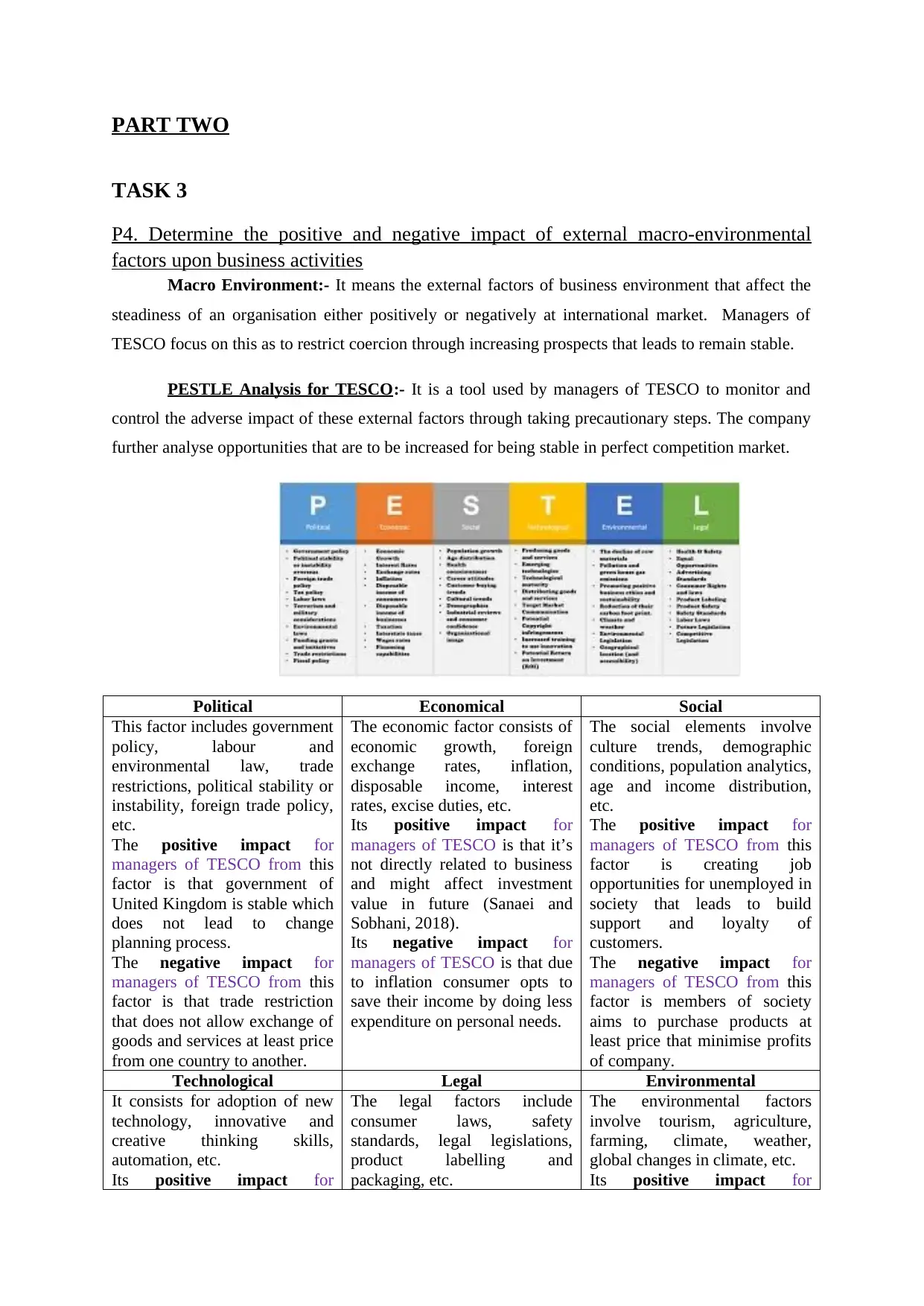
PART TWO
TASK 3
P4. Determine the positive and negative impact of external macro-environmental
factors upon business activities
Macro Environment:- It means the external factors of business environment that affect the
steadiness of an organisation either positively or negatively at international market. Managers of
TESCO focus on this as to restrict coercion through increasing prospects that leads to remain stable.
PESTLE Analysis for TESCO:- It is a tool used by managers of TESCO to monitor and
control the adverse impact of these external factors through taking precautionary steps. The company
further analyse opportunities that are to be increased for being stable in perfect competition market.
Political Economical Social
This factor includes government
policy, labour and
environmental law, trade
restrictions, political stability or
instability, foreign trade policy,
etc.
The positive impact for
managers of TESCO from this
factor is that government of
United Kingdom is stable which
does not lead to change
planning process.
The negative impact for
managers of TESCO from this
factor is that trade restriction
that does not allow exchange of
goods and services at least price
from one country to another.
The economic factor consists of
economic growth, foreign
exchange rates, inflation,
disposable income, interest
rates, excise duties, etc.
Its positive impact for
managers of TESCO is that it’s
not directly related to business
and might affect investment
value in future (Sanaei and
Sobhani, 2018).
Its negative impact for
managers of TESCO is that due
to inflation consumer opts to
save their income by doing less
expenditure on personal needs.
The social elements involve
culture trends, demographic
conditions, population analytics,
age and income distribution,
etc.
The positive impact for
managers of TESCO from this
factor is creating job
opportunities for unemployed in
society that leads to build
support and loyalty of
customers.
The negative impact for
managers of TESCO from this
factor is members of society
aims to purchase products at
least price that minimise profits
of company.
Technological Legal Environmental
It consists for adoption of new
technology, innovative and
creative thinking skills,
automation, etc.
Its positive impact for
The legal factors include
consumer laws, safety
standards, legal legislations,
product labelling and
packaging, etc.
The environmental factors
involve tourism, agriculture,
farming, climate, weather,
global changes in climate, etc.
Its positive impact for
TASK 3
P4. Determine the positive and negative impact of external macro-environmental
factors upon business activities
Macro Environment:- It means the external factors of business environment that affect the
steadiness of an organisation either positively or negatively at international market. Managers of
TESCO focus on this as to restrict coercion through increasing prospects that leads to remain stable.
PESTLE Analysis for TESCO:- It is a tool used by managers of TESCO to monitor and
control the adverse impact of these external factors through taking precautionary steps. The company
further analyse opportunities that are to be increased for being stable in perfect competition market.
Political Economical Social
This factor includes government
policy, labour and
environmental law, trade
restrictions, political stability or
instability, foreign trade policy,
etc.
The positive impact for
managers of TESCO from this
factor is that government of
United Kingdom is stable which
does not lead to change
planning process.
The negative impact for
managers of TESCO from this
factor is that trade restriction
that does not allow exchange of
goods and services at least price
from one country to another.
The economic factor consists of
economic growth, foreign
exchange rates, inflation,
disposable income, interest
rates, excise duties, etc.
Its positive impact for
managers of TESCO is that it’s
not directly related to business
and might affect investment
value in future (Sanaei and
Sobhani, 2018).
Its negative impact for
managers of TESCO is that due
to inflation consumer opts to
save their income by doing less
expenditure on personal needs.
The social elements involve
culture trends, demographic
conditions, population analytics,
age and income distribution,
etc.
The positive impact for
managers of TESCO from this
factor is creating job
opportunities for unemployed in
society that leads to build
support and loyalty of
customers.
The negative impact for
managers of TESCO from this
factor is members of society
aims to purchase products at
least price that minimise profits
of company.
Technological Legal Environmental
It consists for adoption of new
technology, innovative and
creative thinking skills,
automation, etc.
Its positive impact for
The legal factors include
consumer laws, safety
standards, legal legislations,
product labelling and
packaging, etc.
The environmental factors
involve tourism, agriculture,
farming, climate, weather,
global changes in climate, etc.
Its positive impact for
Secure Best Marks with AI Grader
Need help grading? Try our AI Grader for instant feedback on your assignments.
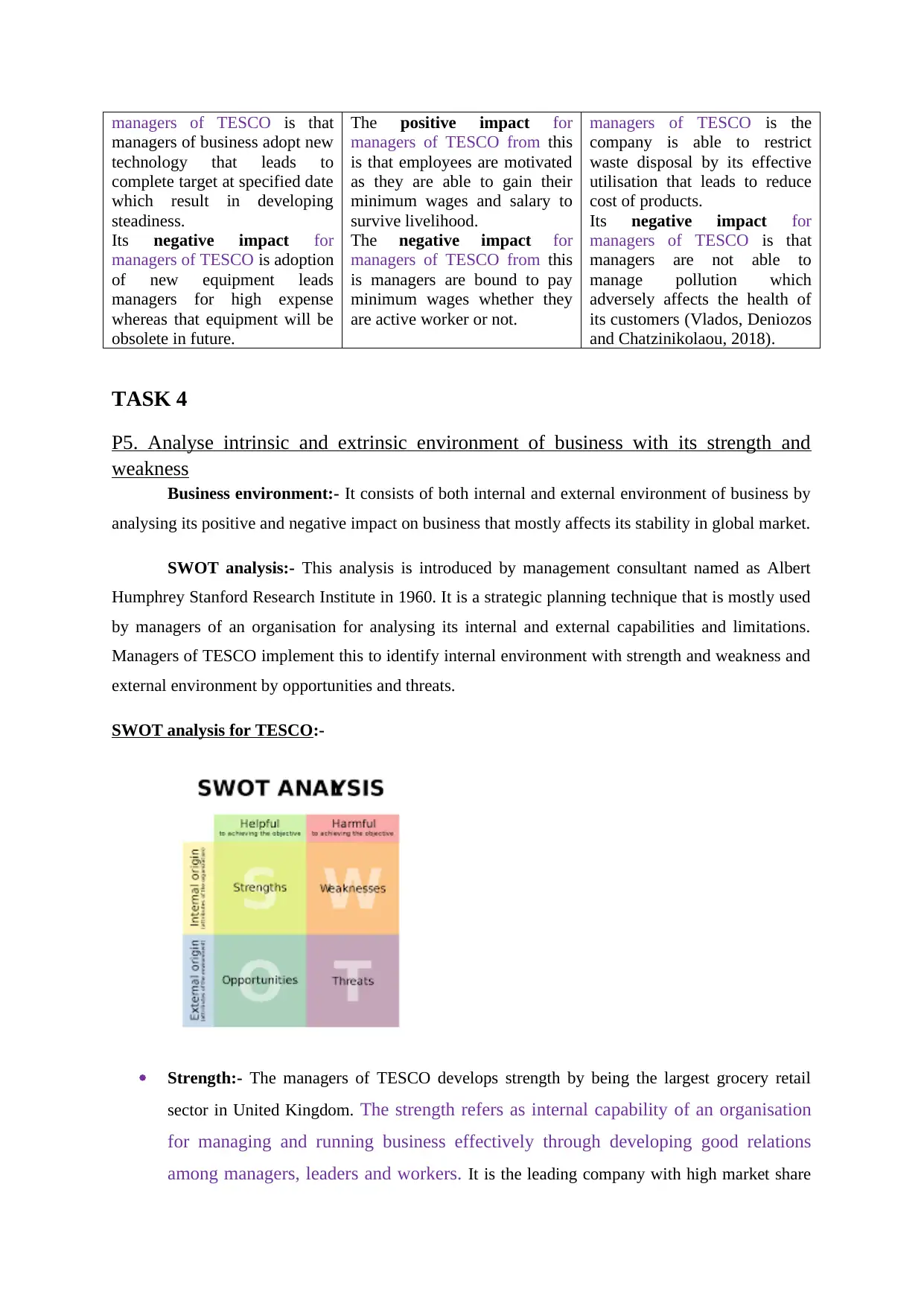
managers of TESCO is that
managers of business adopt new
technology that leads to
complete target at specified date
which result in developing
steadiness.
Its negative impact for
managers of TESCO is adoption
of new equipment leads
managers for high expense
whereas that equipment will be
obsolete in future.
The positive impact for
managers of TESCO from this
is that employees are motivated
as they are able to gain their
minimum wages and salary to
survive livelihood.
The negative impact for
managers of TESCO from this
is managers are bound to pay
minimum wages whether they
are active worker or not.
managers of TESCO is the
company is able to restrict
waste disposal by its effective
utilisation that leads to reduce
cost of products.
Its negative impact for
managers of TESCO is that
managers are not able to
manage pollution which
adversely affects the health of
its customers (Vlados, Deniozos
and Chatzinikolaou, 2018).
TASK 4
P5. Analyse intrinsic and extrinsic environment of business with its strength and
weakness
Business environment:- It consists of both internal and external environment of business by
analysing its positive and negative impact on business that mostly affects its stability in global market.
SWOT analysis:- This analysis is introduced by management consultant named as Albert
Humphrey Stanford Research Institute in 1960. It is a strategic planning technique that is mostly used
by managers of an organisation for analysing its internal and external capabilities and limitations.
Managers of TESCO implement this to identify internal environment with strength and weakness and
external environment by opportunities and threats.
SWOT analysis for TESCO:-
Strength:- The managers of TESCO develops strength by being the largest grocery retail
sector in United Kingdom. The strength refers as internal capability of an organisation
for managing and running business effectively through developing good relations
among managers, leaders and workers. It is the leading company with high market share
managers of business adopt new
technology that leads to
complete target at specified date
which result in developing
steadiness.
Its negative impact for
managers of TESCO is adoption
of new equipment leads
managers for high expense
whereas that equipment will be
obsolete in future.
The positive impact for
managers of TESCO from this
is that employees are motivated
as they are able to gain their
minimum wages and salary to
survive livelihood.
The negative impact for
managers of TESCO from this
is managers are bound to pay
minimum wages whether they
are active worker or not.
managers of TESCO is the
company is able to restrict
waste disposal by its effective
utilisation that leads to reduce
cost of products.
Its negative impact for
managers of TESCO is that
managers are not able to
manage pollution which
adversely affects the health of
its customers (Vlados, Deniozos
and Chatzinikolaou, 2018).
TASK 4
P5. Analyse intrinsic and extrinsic environment of business with its strength and
weakness
Business environment:- It consists of both internal and external environment of business by
analysing its positive and negative impact on business that mostly affects its stability in global market.
SWOT analysis:- This analysis is introduced by management consultant named as Albert
Humphrey Stanford Research Institute in 1960. It is a strategic planning technique that is mostly used
by managers of an organisation for analysing its internal and external capabilities and limitations.
Managers of TESCO implement this to identify internal environment with strength and weakness and
external environment by opportunities and threats.
SWOT analysis for TESCO:-
Strength:- The managers of TESCO develops strength by being the largest grocery retail
sector in United Kingdom. The strength refers as internal capability of an organisation
for managing and running business effectively through developing good relations
among managers, leaders and workers. It is the leading company with high market share
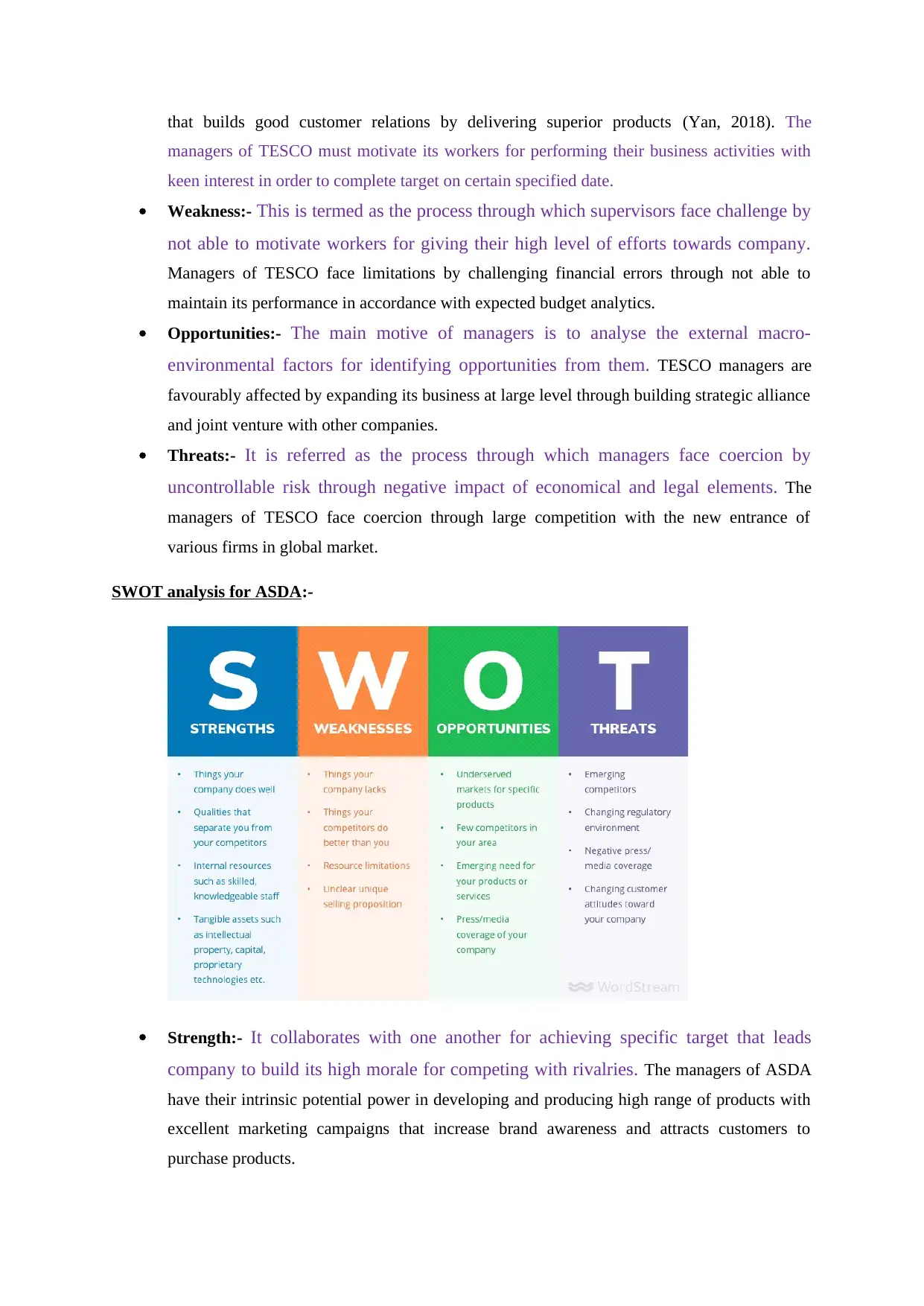
that builds good customer relations by delivering superior products (Yan, 2018). The
managers of TESCO must motivate its workers for performing their business activities with
keen interest in order to complete target on certain specified date.
Weakness:- This is termed as the process through which supervisors face challenge by
not able to motivate workers for giving their high level of efforts towards company.
Managers of TESCO face limitations by challenging financial errors through not able to
maintain its performance in accordance with expected budget analytics.
Opportunities:- The main motive of managers is to analyse the external macro-
environmental factors for identifying opportunities from them. TESCO managers are
favourably affected by expanding its business at large level through building strategic alliance
and joint venture with other companies.
Threats:- It is referred as the process through which managers face coercion by
uncontrollable risk through negative impact of economical and legal elements. The
managers of TESCO face coercion through large competition with the new entrance of
various firms in global market.
SWOT analysis for ASDA:-
Strength:- It collaborates with one another for achieving specific target that leads
company to build its high morale for competing with rivalries. The managers of ASDA
have their intrinsic potential power in developing and producing high range of products with
excellent marketing campaigns that increase brand awareness and attracts customers to
purchase products.
managers of TESCO must motivate its workers for performing their business activities with
keen interest in order to complete target on certain specified date.
Weakness:- This is termed as the process through which supervisors face challenge by
not able to motivate workers for giving their high level of efforts towards company.
Managers of TESCO face limitations by challenging financial errors through not able to
maintain its performance in accordance with expected budget analytics.
Opportunities:- The main motive of managers is to analyse the external macro-
environmental factors for identifying opportunities from them. TESCO managers are
favourably affected by expanding its business at large level through building strategic alliance
and joint venture with other companies.
Threats:- It is referred as the process through which managers face coercion by
uncontrollable risk through negative impact of economical and legal elements. The
managers of TESCO face coercion through large competition with the new entrance of
various firms in global market.
SWOT analysis for ASDA:-
Strength:- It collaborates with one another for achieving specific target that leads
company to build its high morale for competing with rivalries. The managers of ASDA
have their intrinsic potential power in developing and producing high range of products with
excellent marketing campaigns that increase brand awareness and attracts customers to
purchase products.

Weakness:- Managers of ASDA face weakness with its daily price fixing cost that restrict the
possibility of buyers to bargain. It further has limited global presence that affects its stability
in perfect competition market. The company majorly emphasize on this as to restrict the
controllable risk through improving its strength that leads to develop competitive
advantage.
Opportunities:- ASDA managers are highly capable in expanding their business into New
Domains with extension to new countries. It further implements effective use of online
marketing that leads to increase sale. It is most important for company to determine the
positive impacts of political, social, technological and environmental factors.
Threats:- The managers of ASDA are negatively impacted by change in government policies
and its fixed price as compared to its rivalries. The company further takes protective
measures to minimise the adverse affects of natural disasters, waste management, etc.
From the above mentioned SWOT analysis of two companies, the TESCO managers are
highly profitable as they have increased their competitive strategies by raising their potential
power and opportunity of company. The managers of ASDA further take protective measures to
minimise controllable and uncontrollable risk.
P6. Describe the strength and weakness for external macro factors of business
The strength of external factors creates prospect for company to remain stable on its position
at international market. The weakness of macro elements develops pressure that has to be minimised
efficiently as it might affect steadiness of business.
Macro-Environmental
Factors
Strength Weakness
Political The managers of TESCO are
favourably affected as there is
continuous change in political
leaders that leads to remain
same policies and procedures.
The managers of TESCO are
unfavourably affected as trade
restriction that does not allow
exchange of goods and services
at least price from one country
to another.
Economical TESCO managers are positively
impacted as this economic
factor does not have direct
relation with business and have
the ability to increase Gross
Domestic Product rate.
TESCO managers are
negatively impacted by people
aims to restricts expense with
inflation rate by postponing
their unwanted expenditure for
future period, that result in
possibility of buyers to bargain. It further has limited global presence that affects its stability
in perfect competition market. The company majorly emphasize on this as to restrict the
controllable risk through improving its strength that leads to develop competitive
advantage.
Opportunities:- ASDA managers are highly capable in expanding their business into New
Domains with extension to new countries. It further implements effective use of online
marketing that leads to increase sale. It is most important for company to determine the
positive impacts of political, social, technological and environmental factors.
Threats:- The managers of ASDA are negatively impacted by change in government policies
and its fixed price as compared to its rivalries. The company further takes protective
measures to minimise the adverse affects of natural disasters, waste management, etc.
From the above mentioned SWOT analysis of two companies, the TESCO managers are
highly profitable as they have increased their competitive strategies by raising their potential
power and opportunity of company. The managers of ASDA further take protective measures to
minimise controllable and uncontrollable risk.
P6. Describe the strength and weakness for external macro factors of business
The strength of external factors creates prospect for company to remain stable on its position
at international market. The weakness of macro elements develops pressure that has to be minimised
efficiently as it might affect steadiness of business.
Macro-Environmental
Factors
Strength Weakness
Political The managers of TESCO are
favourably affected as there is
continuous change in political
leaders that leads to remain
same policies and procedures.
The managers of TESCO are
unfavourably affected as trade
restriction that does not allow
exchange of goods and services
at least price from one country
to another.
Economical TESCO managers are positively
impacted as this economic
factor does not have direct
relation with business and have
the ability to increase Gross
Domestic Product rate.
TESCO managers are
negatively impacted by people
aims to restricts expense with
inflation rate by postponing
their unwanted expenditure for
future period, that result in
Paraphrase This Document
Need a fresh take? Get an instant paraphrase of this document with our AI Paraphraser
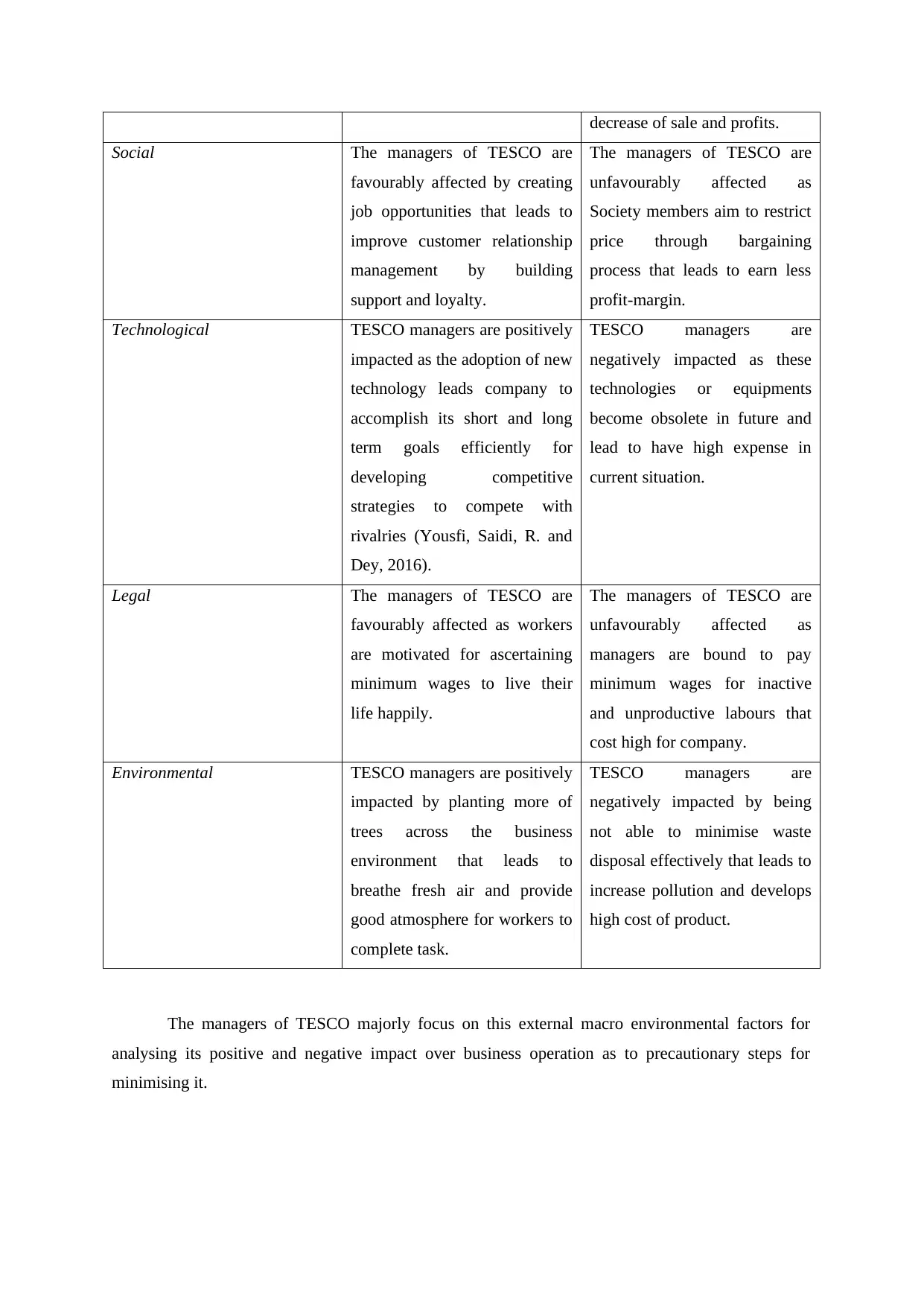
decrease of sale and profits.
Social The managers of TESCO are
favourably affected by creating
job opportunities that leads to
improve customer relationship
management by building
support and loyalty.
The managers of TESCO are
unfavourably affected as
Society members aim to restrict
price through bargaining
process that leads to earn less
profit-margin.
Technological TESCO managers are positively
impacted as the adoption of new
technology leads company to
accomplish its short and long
term goals efficiently for
developing competitive
strategies to compete with
rivalries (Yousfi, Saidi, R. and
Dey, 2016).
TESCO managers are
negatively impacted as these
technologies or equipments
become obsolete in future and
lead to have high expense in
current situation.
Legal The managers of TESCO are
favourably affected as workers
are motivated for ascertaining
minimum wages to live their
life happily.
The managers of TESCO are
unfavourably affected as
managers are bound to pay
minimum wages for inactive
and unproductive labours that
cost high for company.
Environmental TESCO managers are positively
impacted by planting more of
trees across the business
environment that leads to
breathe fresh air and provide
good atmosphere for workers to
complete task.
TESCO managers are
negatively impacted by being
not able to minimise waste
disposal effectively that leads to
increase pollution and develops
high cost of product.
The managers of TESCO majorly focus on this external macro environmental factors for
analysing its positive and negative impact over business operation as to precautionary steps for
minimising it.
Social The managers of TESCO are
favourably affected by creating
job opportunities that leads to
improve customer relationship
management by building
support and loyalty.
The managers of TESCO are
unfavourably affected as
Society members aim to restrict
price through bargaining
process that leads to earn less
profit-margin.
Technological TESCO managers are positively
impacted as the adoption of new
technology leads company to
accomplish its short and long
term goals efficiently for
developing competitive
strategies to compete with
rivalries (Yousfi, Saidi, R. and
Dey, 2016).
TESCO managers are
negatively impacted as these
technologies or equipments
become obsolete in future and
lead to have high expense in
current situation.
Legal The managers of TESCO are
favourably affected as workers
are motivated for ascertaining
minimum wages to live their
life happily.
The managers of TESCO are
unfavourably affected as
managers are bound to pay
minimum wages for inactive
and unproductive labours that
cost high for company.
Environmental TESCO managers are positively
impacted by planting more of
trees across the business
environment that leads to
breathe fresh air and provide
good atmosphere for workers to
complete task.
TESCO managers are
negatively impacted by being
not able to minimise waste
disposal effectively that leads to
increase pollution and develops
high cost of product.
The managers of TESCO majorly focus on this external macro environmental factors for
analysing its positive and negative impact over business operation as to precautionary steps for
minimising it.
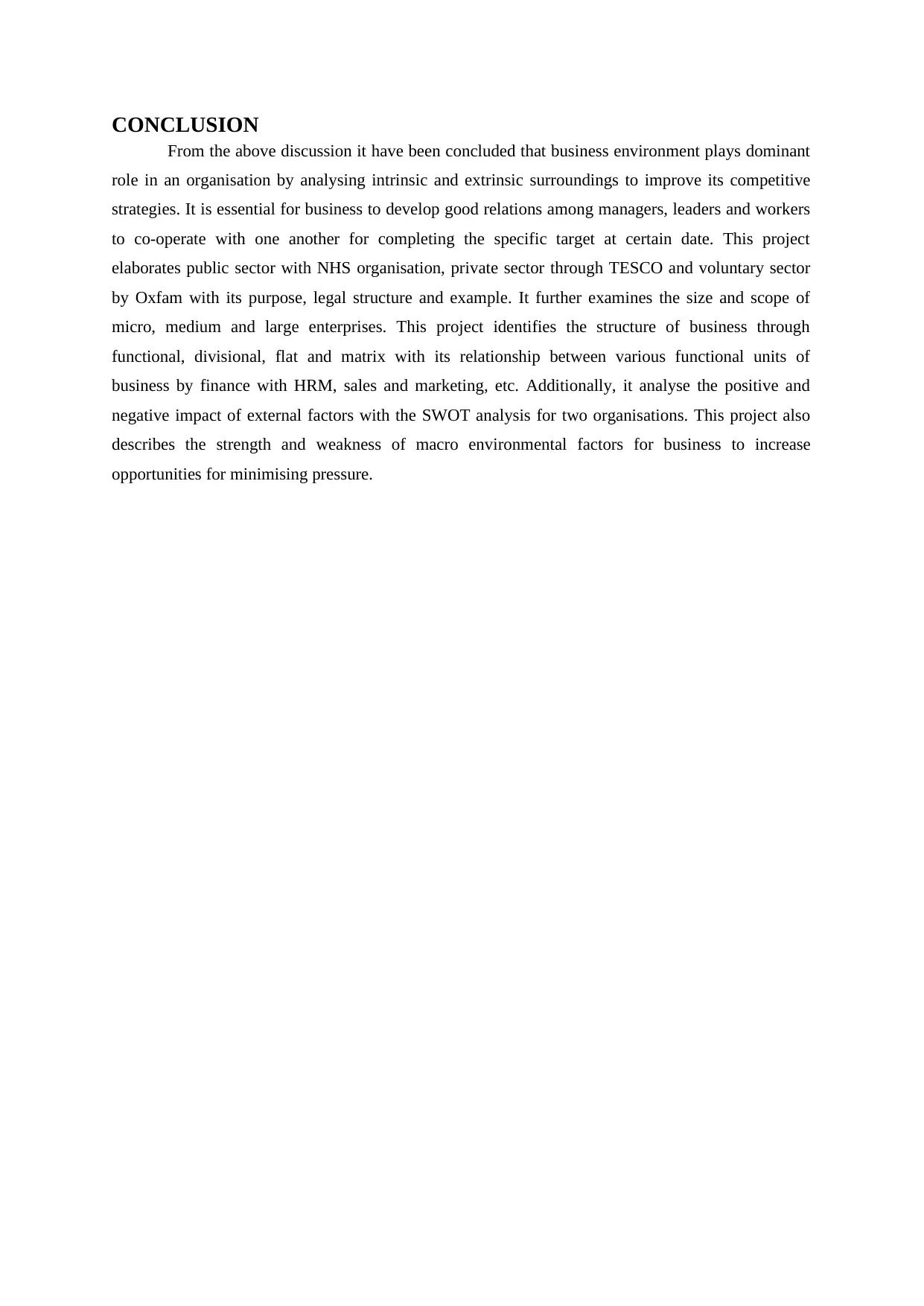
CONCLUSION
From the above discussion it have been concluded that business environment plays dominant
role in an organisation by analysing intrinsic and extrinsic surroundings to improve its competitive
strategies. It is essential for business to develop good relations among managers, leaders and workers
to co-operate with one another for completing the specific target at certain date. This project
elaborates public sector with NHS organisation, private sector through TESCO and voluntary sector
by Oxfam with its purpose, legal structure and example. It further examines the size and scope of
micro, medium and large enterprises. This project identifies the structure of business through
functional, divisional, flat and matrix with its relationship between various functional units of
business by finance with HRM, sales and marketing, etc. Additionally, it analyse the positive and
negative impact of external factors with the SWOT analysis for two organisations. This project also
describes the strength and weakness of macro environmental factors for business to increase
opportunities for minimising pressure.
From the above discussion it have been concluded that business environment plays dominant
role in an organisation by analysing intrinsic and extrinsic surroundings to improve its competitive
strategies. It is essential for business to develop good relations among managers, leaders and workers
to co-operate with one another for completing the specific target at certain date. This project
elaborates public sector with NHS organisation, private sector through TESCO and voluntary sector
by Oxfam with its purpose, legal structure and example. It further examines the size and scope of
micro, medium and large enterprises. This project identifies the structure of business through
functional, divisional, flat and matrix with its relationship between various functional units of
business by finance with HRM, sales and marketing, etc. Additionally, it analyse the positive and
negative impact of external factors with the SWOT analysis for two organisations. This project also
describes the strength and weakness of macro environmental factors for business to increase
opportunities for minimising pressure.
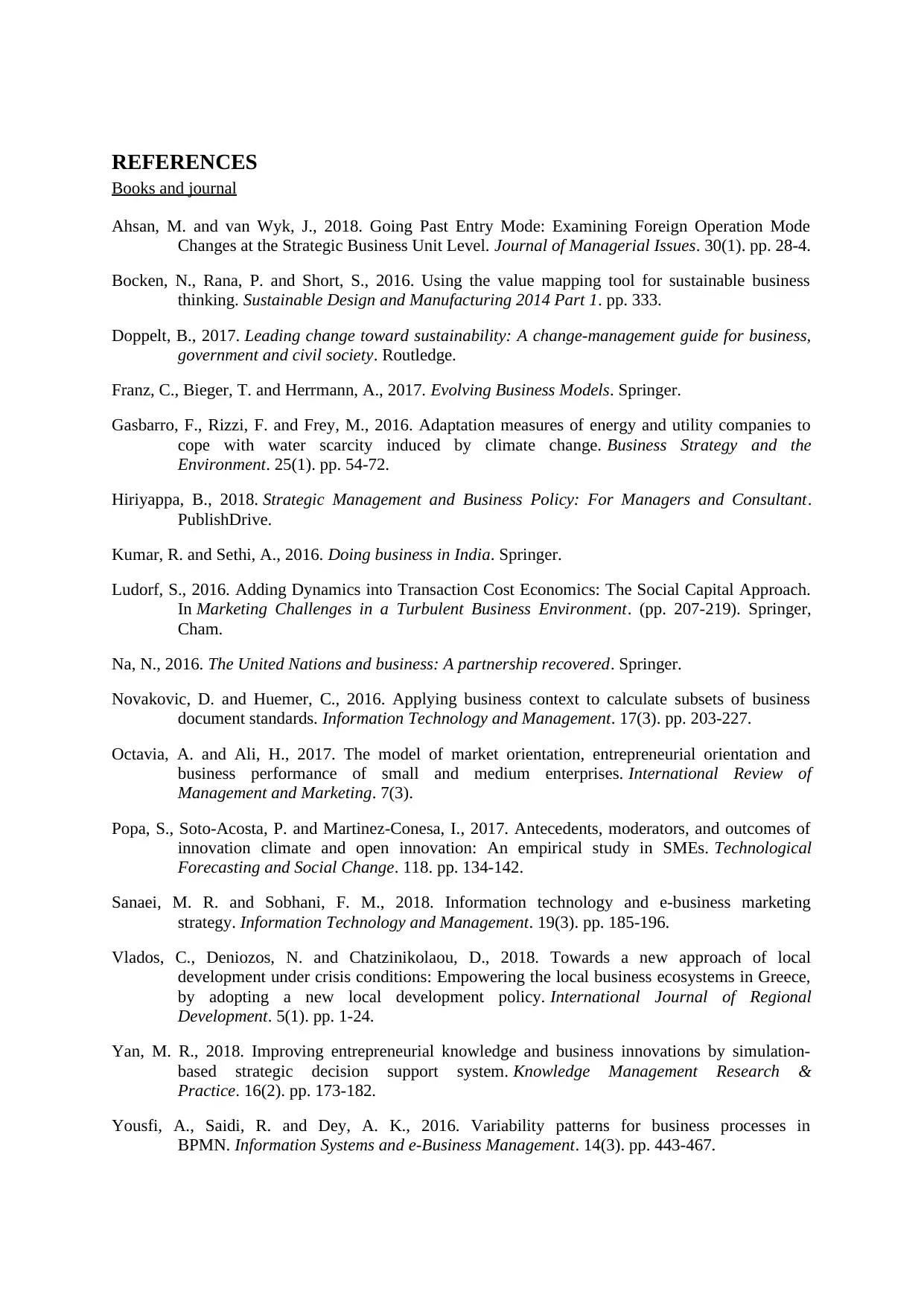
REFERENCES
Books and journal
Ahsan, M. and van Wyk, J., 2018. Going Past Entry Mode: Examining Foreign Operation Mode
Changes at the Strategic Business Unit Level. Journal of Managerial Issues. 30(1). pp. 28-4.
Bocken, N., Rana, P. and Short, S., 2016. Using the value mapping tool for sustainable business
thinking. Sustainable Design and Manufacturing 2014 Part 1. pp. 333.
Doppelt, B., 2017. Leading change toward sustainability: A change-management guide for business,
government and civil society. Routledge.
Franz, C., Bieger, T. and Herrmann, A., 2017. Evolving Business Models. Springer.
Gasbarro, F., Rizzi, F. and Frey, M., 2016. Adaptation measures of energy and utility companies to
cope with water scarcity induced by climate change. Business Strategy and the
Environment. 25(1). pp. 54-72.
Hiriyappa, B., 2018. Strategic Management and Business Policy: For Managers and Consultant.
PublishDrive.
Kumar, R. and Sethi, A., 2016. Doing business in India. Springer.
Ludorf, S., 2016. Adding Dynamics into Transaction Cost Economics: The Social Capital Approach.
In Marketing Challenges in a Turbulent Business Environment. (pp. 207-219). Springer,
Cham.
Na, N., 2016. The United Nations and business: A partnership recovered. Springer.
Novakovic, D. and Huemer, C., 2016. Applying business context to calculate subsets of business
document standards. Information Technology and Management. 17(3). pp. 203-227.
Octavia, A. and Ali, H., 2017. The model of market orientation, entrepreneurial orientation and
business performance of small and medium enterprises. International Review of
Management and Marketing. 7(3).
Popa, S., Soto-Acosta, P. and Martinez-Conesa, I., 2017. Antecedents, moderators, and outcomes of
innovation climate and open innovation: An empirical study in SMEs. Technological
Forecasting and Social Change. 118. pp. 134-142.
Sanaei, M. R. and Sobhani, F. M., 2018. Information technology and e-business marketing
strategy. Information Technology and Management. 19(3). pp. 185-196.
Vlados, C., Deniozos, N. and Chatzinikolaou, D., 2018. Towards a new approach of local
development under crisis conditions: Empowering the local business ecosystems in Greece,
by adopting a new local development policy. International Journal of Regional
Development. 5(1). pp. 1-24.
Yan, M. R., 2018. Improving entrepreneurial knowledge and business innovations by simulation-
based strategic decision support system. Knowledge Management Research &
Practice. 16(2). pp. 173-182.
Yousfi, A., Saidi, R. and Dey, A. K., 2016. Variability patterns for business processes in
BPMN. Information Systems and e-Business Management. 14(3). pp. 443-467.
Books and journal
Ahsan, M. and van Wyk, J., 2018. Going Past Entry Mode: Examining Foreign Operation Mode
Changes at the Strategic Business Unit Level. Journal of Managerial Issues. 30(1). pp. 28-4.
Bocken, N., Rana, P. and Short, S., 2016. Using the value mapping tool for sustainable business
thinking. Sustainable Design and Manufacturing 2014 Part 1. pp. 333.
Doppelt, B., 2017. Leading change toward sustainability: A change-management guide for business,
government and civil society. Routledge.
Franz, C., Bieger, T. and Herrmann, A., 2017. Evolving Business Models. Springer.
Gasbarro, F., Rizzi, F. and Frey, M., 2016. Adaptation measures of energy and utility companies to
cope with water scarcity induced by climate change. Business Strategy and the
Environment. 25(1). pp. 54-72.
Hiriyappa, B., 2018. Strategic Management and Business Policy: For Managers and Consultant.
PublishDrive.
Kumar, R. and Sethi, A., 2016. Doing business in India. Springer.
Ludorf, S., 2016. Adding Dynamics into Transaction Cost Economics: The Social Capital Approach.
In Marketing Challenges in a Turbulent Business Environment. (pp. 207-219). Springer,
Cham.
Na, N., 2016. The United Nations and business: A partnership recovered. Springer.
Novakovic, D. and Huemer, C., 2016. Applying business context to calculate subsets of business
document standards. Information Technology and Management. 17(3). pp. 203-227.
Octavia, A. and Ali, H., 2017. The model of market orientation, entrepreneurial orientation and
business performance of small and medium enterprises. International Review of
Management and Marketing. 7(3).
Popa, S., Soto-Acosta, P. and Martinez-Conesa, I., 2017. Antecedents, moderators, and outcomes of
innovation climate and open innovation: An empirical study in SMEs. Technological
Forecasting and Social Change. 118. pp. 134-142.
Sanaei, M. R. and Sobhani, F. M., 2018. Information technology and e-business marketing
strategy. Information Technology and Management. 19(3). pp. 185-196.
Vlados, C., Deniozos, N. and Chatzinikolaou, D., 2018. Towards a new approach of local
development under crisis conditions: Empowering the local business ecosystems in Greece,
by adopting a new local development policy. International Journal of Regional
Development. 5(1). pp. 1-24.
Yan, M. R., 2018. Improving entrepreneurial knowledge and business innovations by simulation-
based strategic decision support system. Knowledge Management Research &
Practice. 16(2). pp. 173-182.
Yousfi, A., Saidi, R. and Dey, A. K., 2016. Variability patterns for business processes in
BPMN. Information Systems and e-Business Management. 14(3). pp. 443-467.
Secure Best Marks with AI Grader
Need help grading? Try our AI Grader for instant feedback on your assignments.
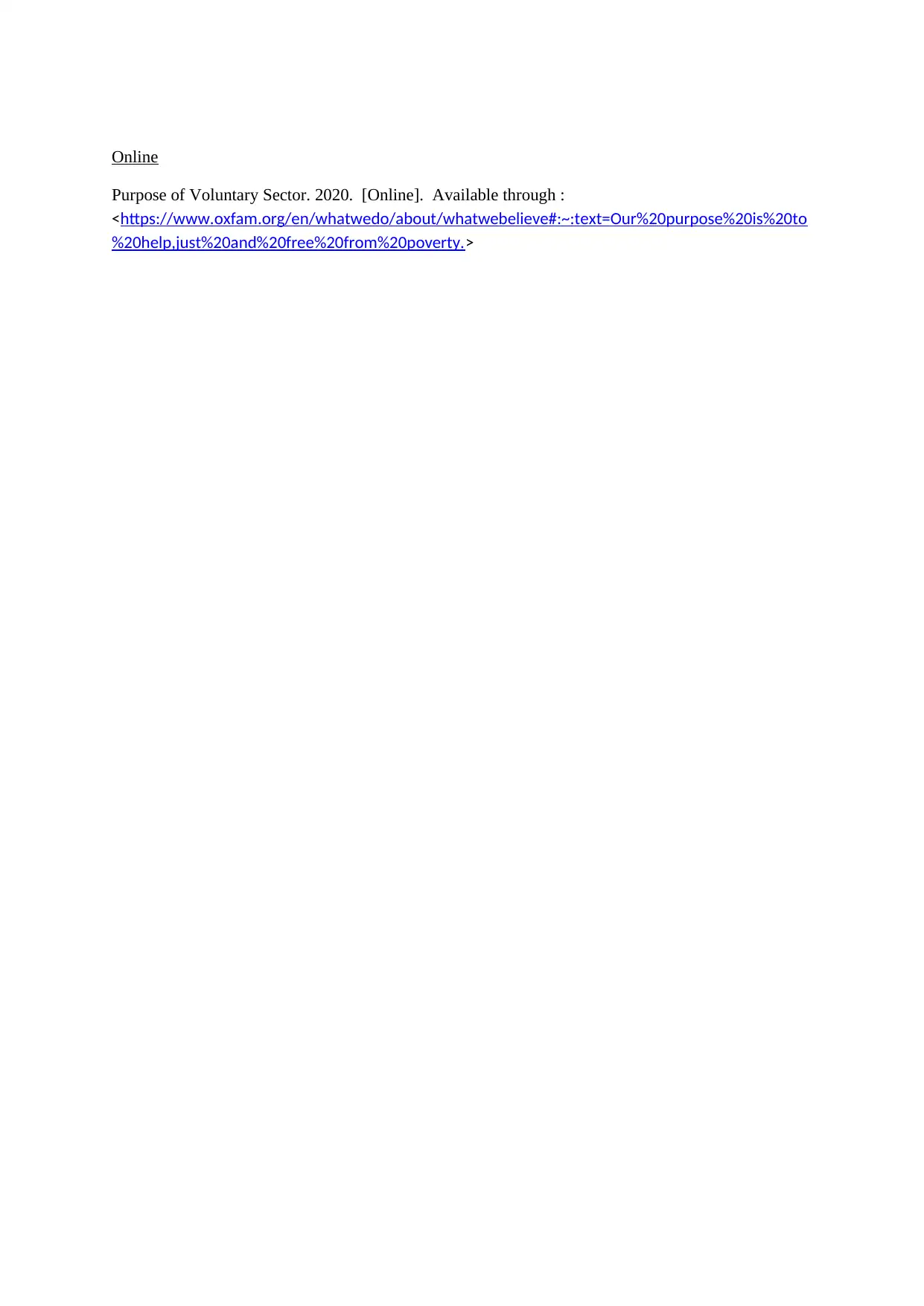
Online
Purpose of Voluntary Sector. 2020. [Online]. Available through :
<https://www.oxfam.org/en/whatwedo/about/whatwebelieve#:~:text=Our%20purpose%20is%20to
%20help,just%20and%20free%20from%20poverty.>
Purpose of Voluntary Sector. 2020. [Online]. Available through :
<https://www.oxfam.org/en/whatwedo/about/whatwebelieve#:~:text=Our%20purpose%20is%20to
%20help,just%20and%20free%20from%20poverty.>
1 out of 17
Related Documents
Your All-in-One AI-Powered Toolkit for Academic Success.
+13062052269
info@desklib.com
Available 24*7 on WhatsApp / Email
![[object Object]](/_next/static/media/star-bottom.7253800d.svg)
Unlock your academic potential
© 2024 | Zucol Services PVT LTD | All rights reserved.





